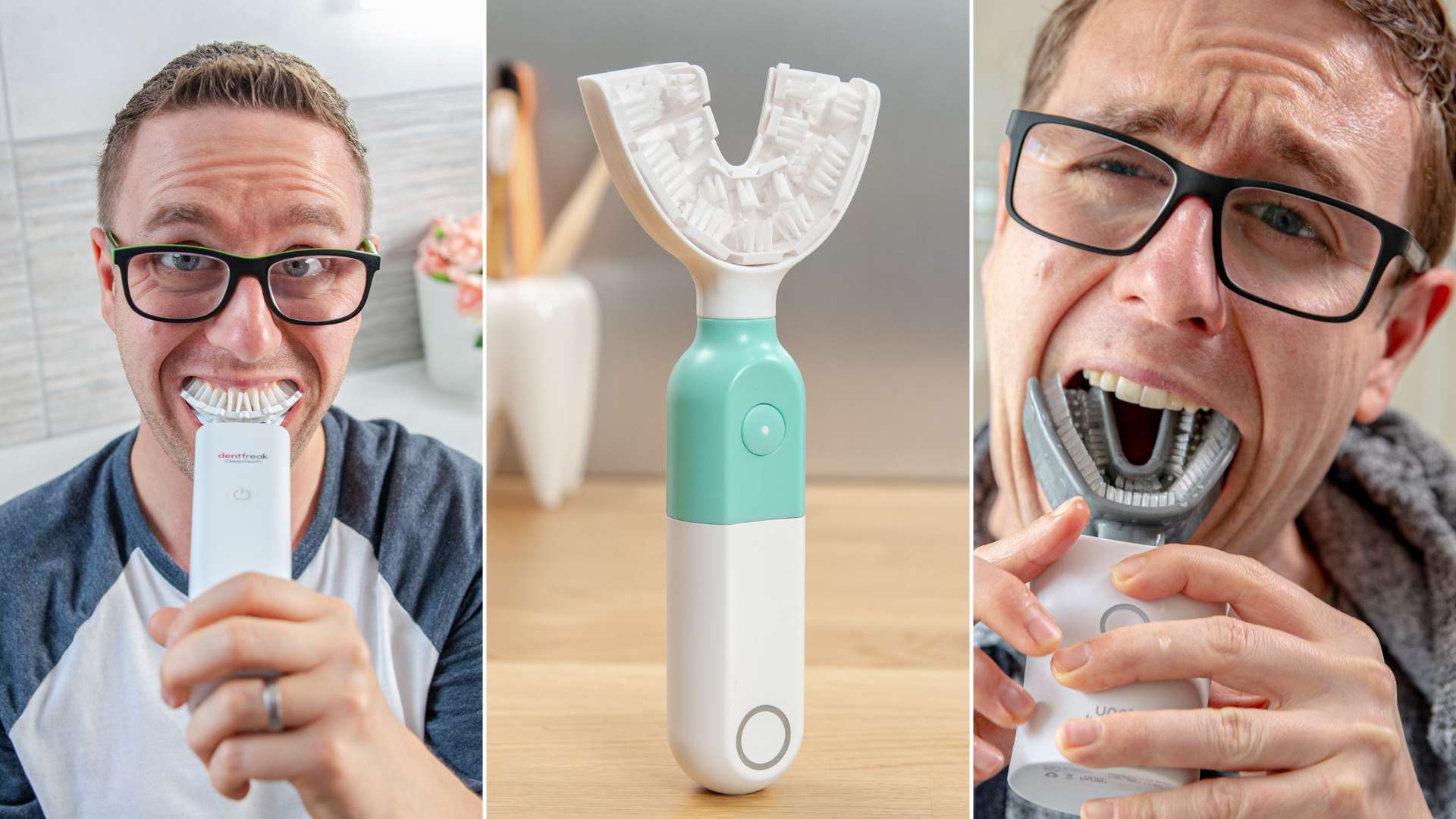
We strongly advise that you DO NOT buy a mouthpiece/automatic toothbrush.*
Our testing shows that with limited exceptions they DO NOT clean the teeth very well.
The health of your teeth and gums is AT RISK if you use these products in place of a regular toothbrush.
Our findings are supported by at least 2 clinical studies, both of which do not advise using such products. (link to clinical data section).
SymplBrush is the best product to date. It achieves surprising results. But, It is very technique sensitive and expensive. It is by no means a must buy product.
Unless you have seen reliable evidence that they work as claimed, you should stick to a regular manual or electric toothbrush.
An evolving marketplace
This style of toothbrush is still relatively new, and as the months go by new products are being created.
As a consequence, the marketplace is forever changing as is the quality, price, and efficacy of these devices.
Small improvements in quality and cleaning results have been seen since the very first items of this type were launched.
SymplBrush is the best performing product to date. The cleaning results are impressive, if used correctly. You need to master the technique to achieve good results. Even then it still falls short of the standard required to replace a regular toothbrush.
Unfortunately, not all manufacturers and sellers are focused on how well the product works.
We have seen an alarming increase in the number capitalising on the unique design and lack of testing, to sell poor quality products to unsuspecting members of the public.
Many lack the evidence to support the pre-sale claims they make.
Want to be notified when new toothbrush technology is announced?

Poor cleaning results: the evidence from our testing
To demonstrate the poor cleaning results that these products currently offer, take a look at the photos below.
In the first image you will see a photo of my teeth taken before and after using a mouthpiece toothbrush.
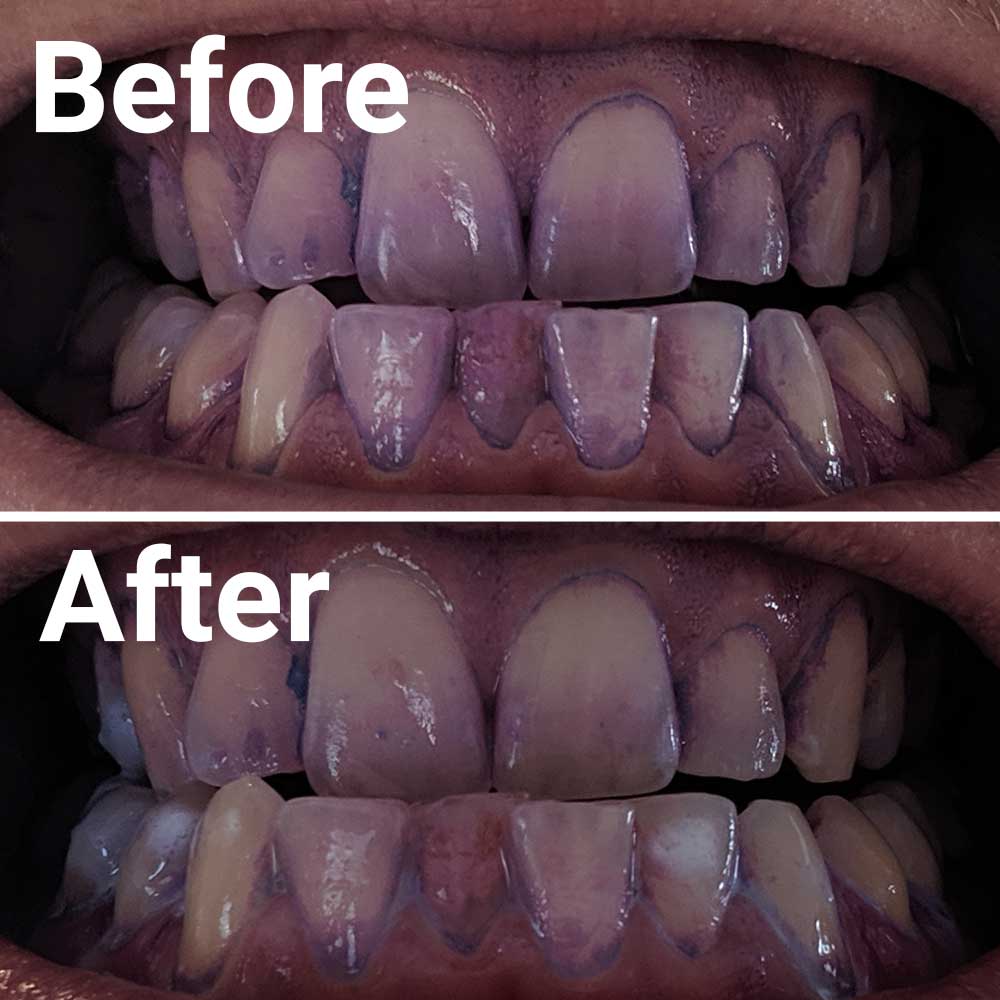
The purple stuff on the teeth is plaque. Normally it is colorless, but we used a plaque disclosing solution to show where it exists on the teeth.
Plaque is the very substance that should be removed from the teeth when you brush them.
If it is not removed, in time, you can end up with unhealthy teeth and gums.
This image is from a real-life test of a mouthpiece toothbrush. You can see how even after use there is a lot of plaque left on the teeth.
SymplBrush is the automatic toothbrush to provide the best results to date, as shown in the image below.
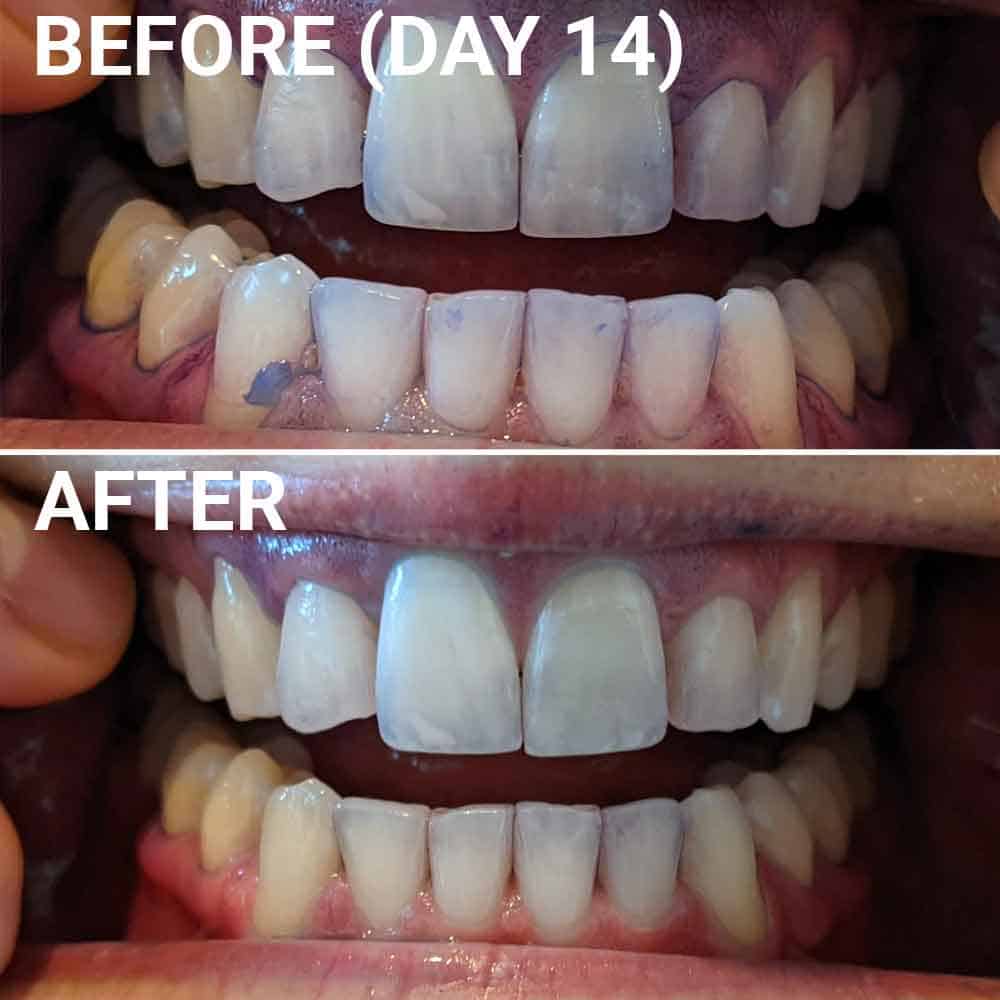
But, whilst pretty impressive, it is still not quite good enough.
SymplBrush comes fairly close to working as well as it should. But, the particular technique required takes time to perfect. Time and patience many won't want to invest.
We have yet to test a mouthpiece toothbrush that could replace a regular toothbrush.
The majority of our tests have resulted in before and after images similar to the first one shown, with lots of plaque left on the teeth.
Used correctly, a manual or electric toothbrush removes all this plaque.
The recommendation is, and continues to be, brush for 2 minutes twice a day and floss at least once. Although statistics show that the average American brushes for just 45 to 70 seconds per day.
The following images show before and after images of plaque removal based on different toothbrushes and cleaning times.
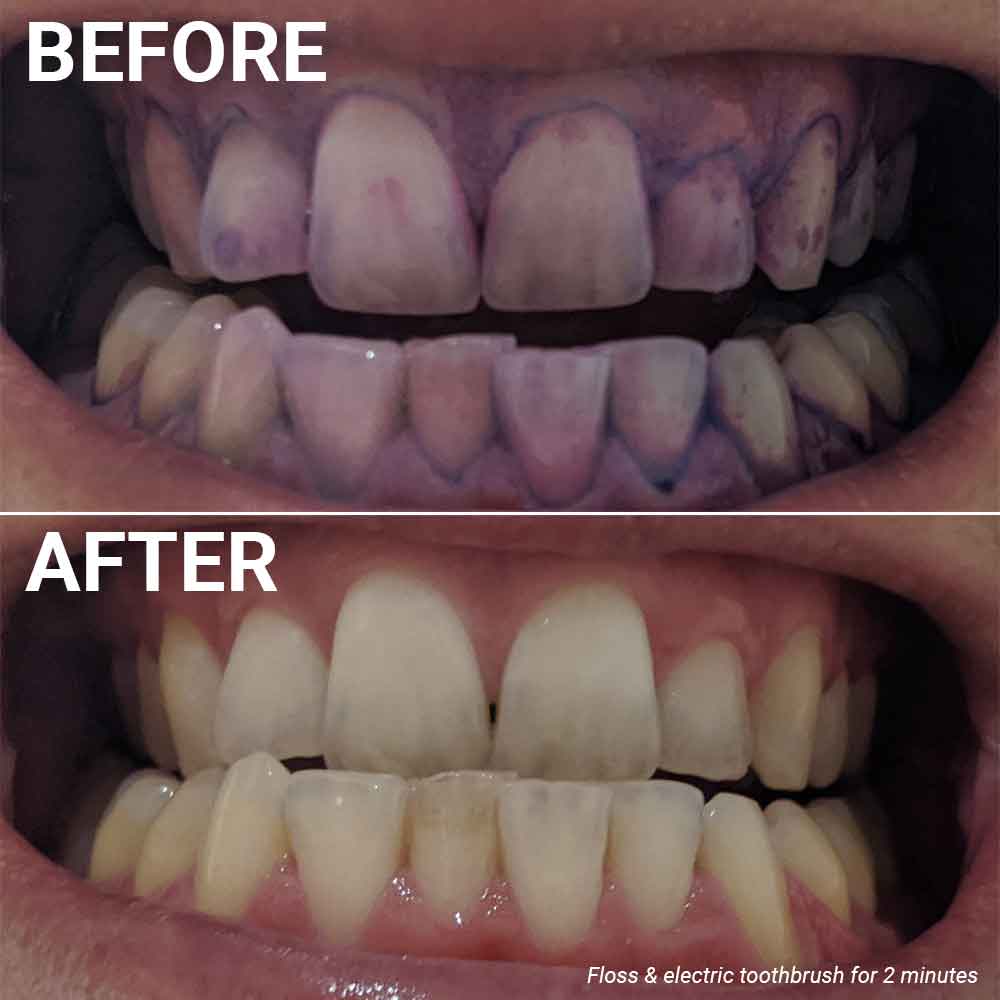
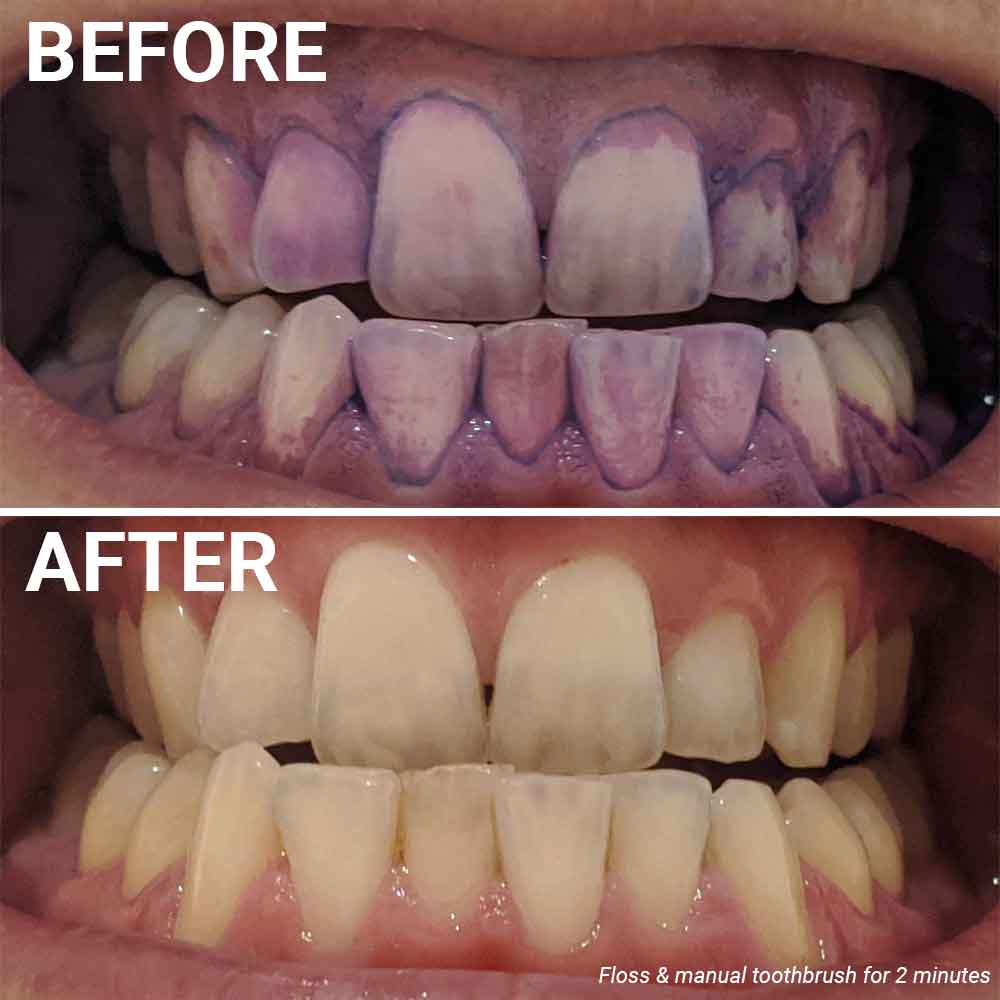
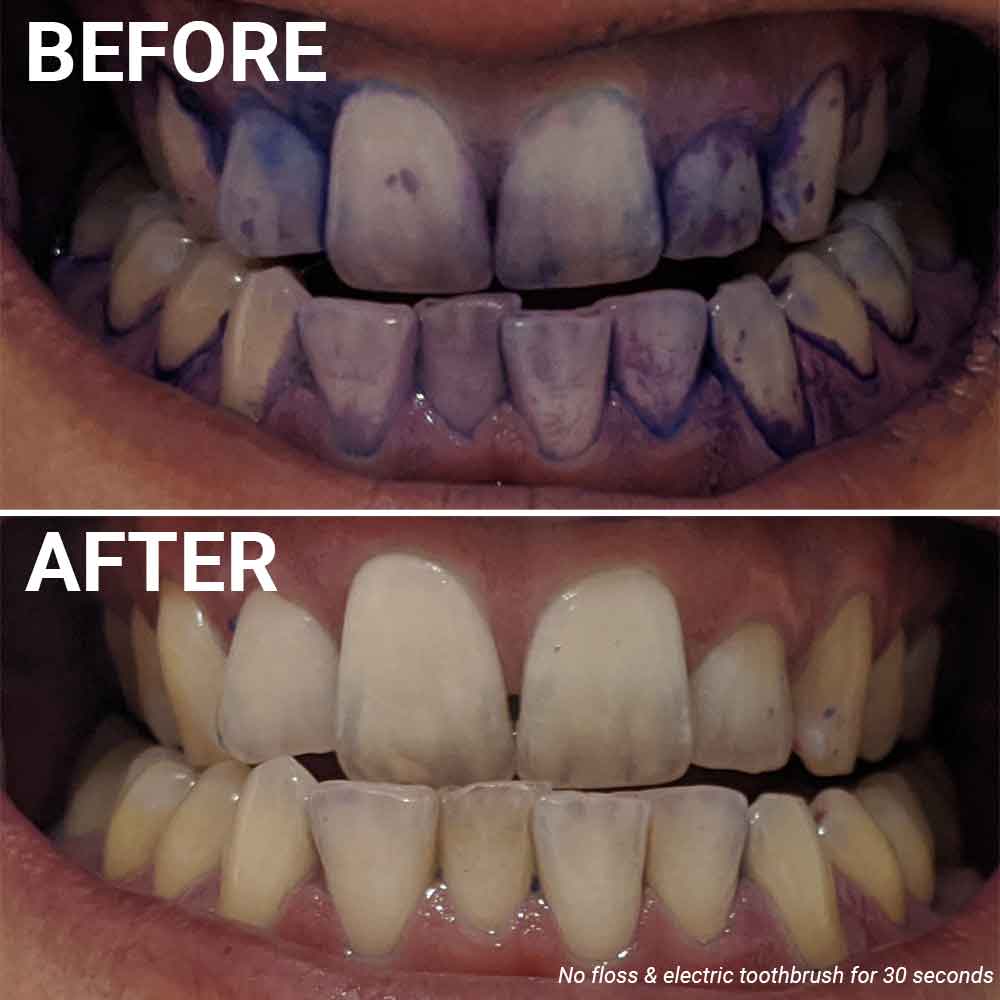
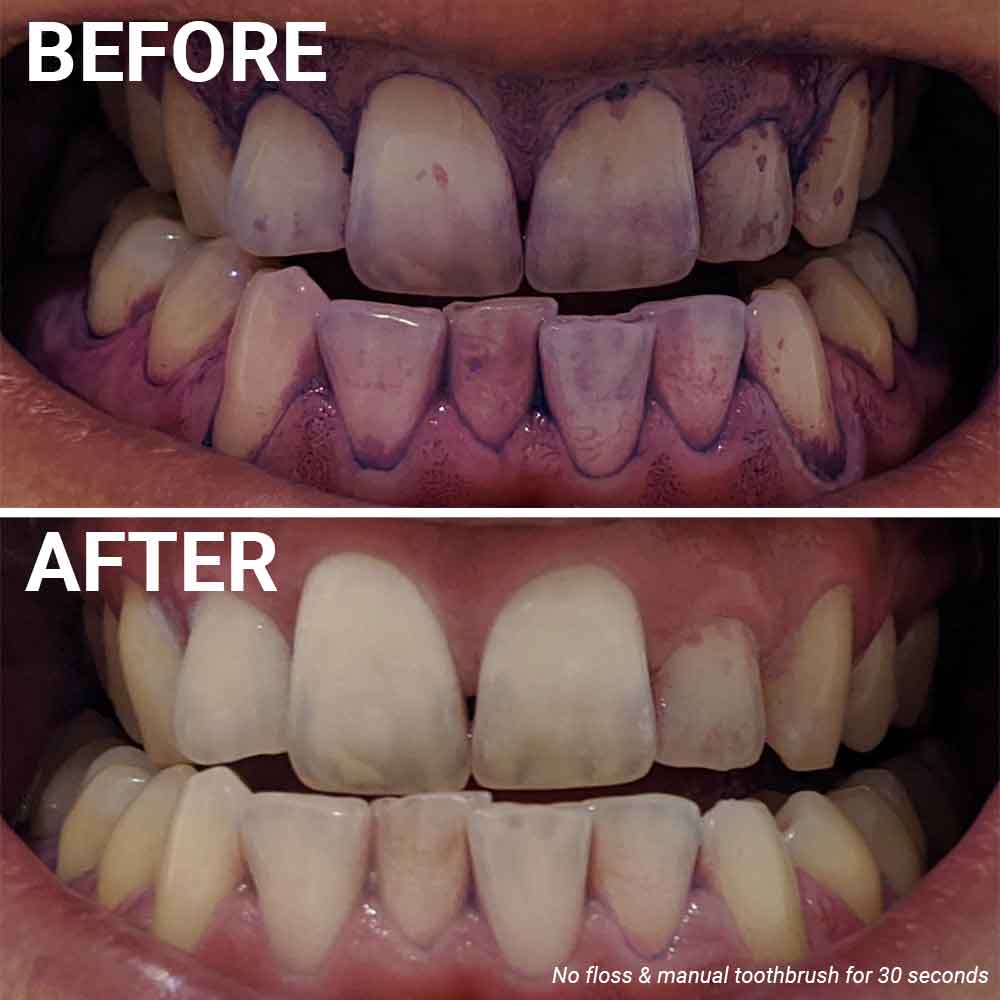
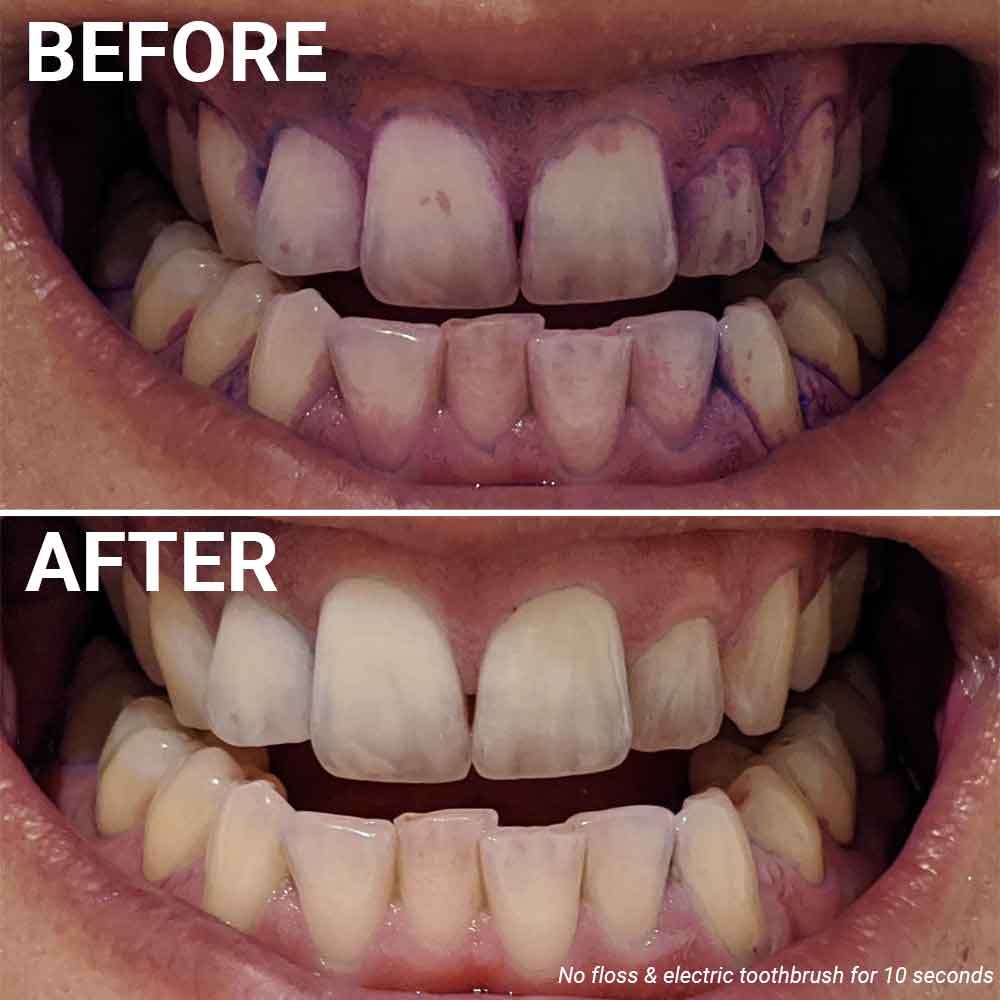
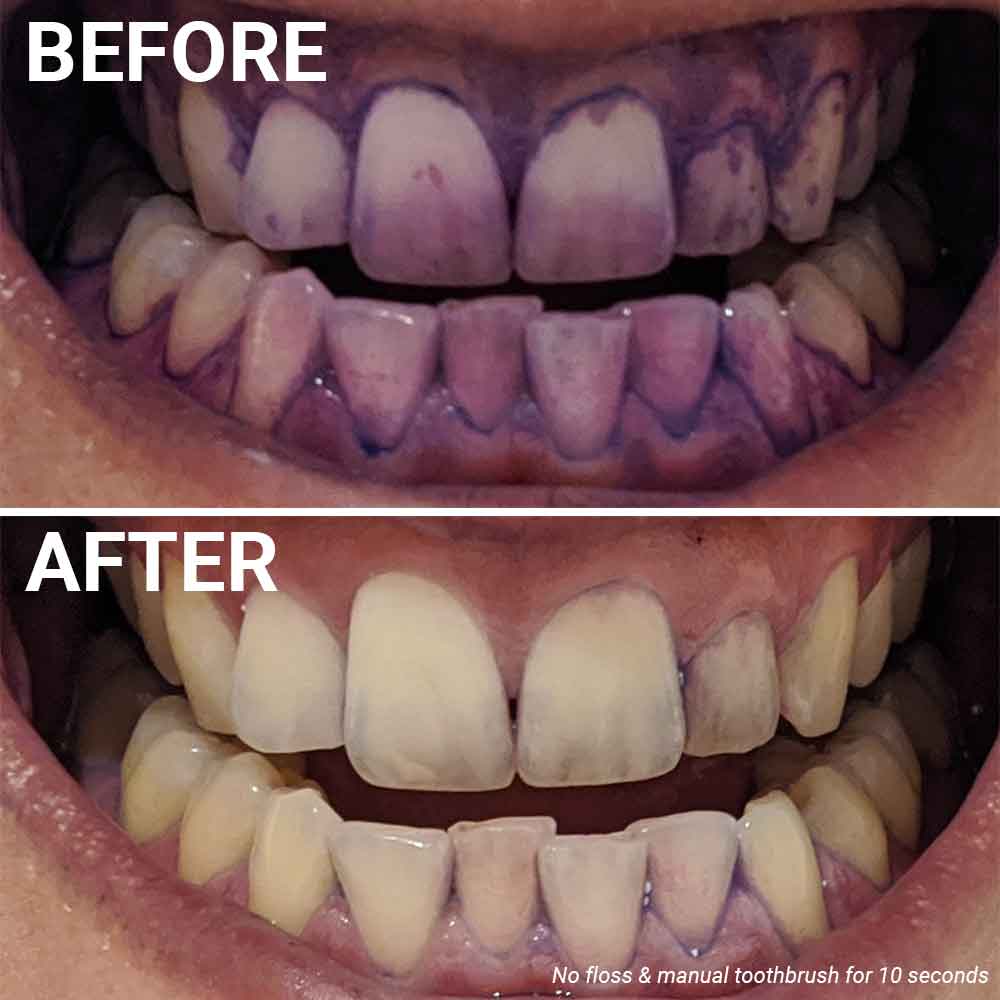
Clinical trials
The ultimate test for any product is how it fares under clinical testing and trials.
In these circumstances dental professionals take a detailed look at such products and test them using standardised procedures to be able to come to informed conclusions on the product and cleaning results.
DDespite being on the market for a few years, it was not until June 2020 that the results of the first two clinical trials were revealed.
Both were relatively small studies. The University of Florence had 22 participants in theirs and the findings were first published in the International Journal of Environmental Research and Public Health.
It looked at the efficacy (how well it cleans) of U shaped automatic electric toothbrush (UAET), in comparison to a manual and electric toothbrush and to not brushing at all.
Whilst they only tested one U shaped toothbrush as part of the study, it was the most popular and best selling product to date, V-White.
The results were pretty damning. The key findings and conclusions were:
- The UAET that was tested in this study proved to be not effective in removing dental plaque.
- The UAET was not significantly different from no brushing.
- Plaque removal with the UAET was significantly lower than with a powered toothbrush and a habitual toothbrushing.
- The use of this U shaped toothbrush cannot be recommended for regular oral hygiene at home.
To add additional context, the V-White brush was actually used for a full 2 minutes during this study, by each participant, rather than the 45 seconds of its longest cleaning mode.
Jon summarises the findings in this video:
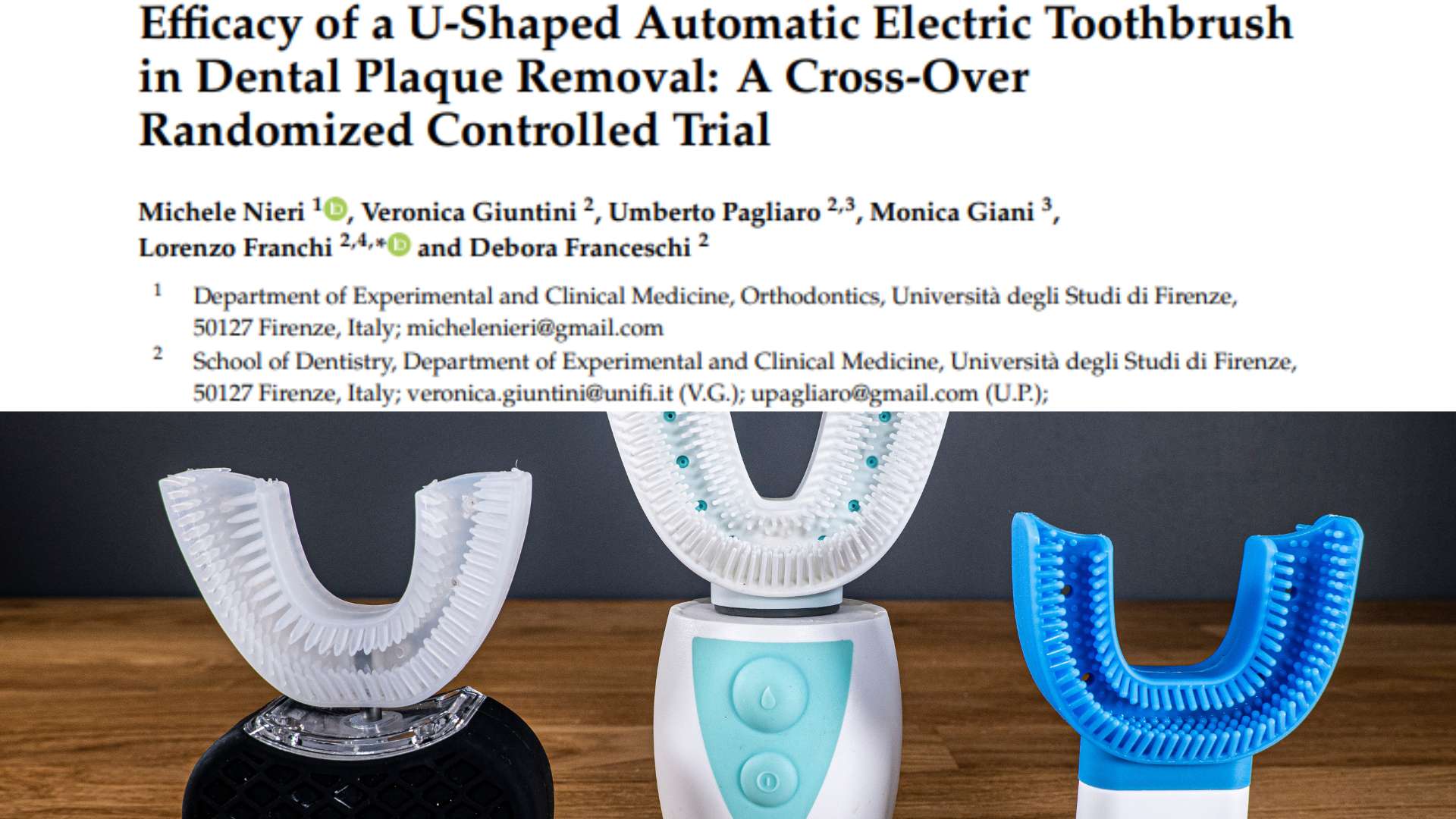
The other study by Schnabl et al has 20 participants and used a different U shaped toothbrush, Amabrush.
They concluded:
- The cleansing efficacy of the auto-cleaning device was clearly inferior to that of manual toothbrushing.
- The alignment and density of the auto-cleaning device’s bristle rows need to be improved, and assorted sizes would be necessary to cover different jaw shapes.
- To date, it is unable to provide sufficient plaque reduction due to an inappropriate bristle alignment and poor fit with diverse dental arches.
The results of these studies reconfirm our own findings, for the vast majority of mouthpiece toothbrushes.
One of the newest options SymplBrush has shown surprisingly good cleaning results.
They have conducted their own research in conjunction with The Forsyth Institute. Researchers found that is was 2x more effective at reducing gingivitis than a manual toothbrush and there is 70% greater reduction in harmful inflammatory markers than a manual toothbrush.
Positive results, but this is by no means conclusive. More independent research is needed. They are the first brand that we are aware of to actively invest in such research.
This remains the only clinical testing we know of to date.
What our in-house dentist says
We asked our in-house dental advisor Dr. Chhaya Chauhan what her thoughts are on mouthpiece toothbrushes, here's what she had to say:

Social media adverts: beware
We have seen a large number of adverts on social media channels such as Instagram, Facebook and Twitter that heavily promote this type of toothbrush.
The images and promotional videos suggest that they work. THEY DON’T.
There will often be lots of 4 and 5* reviews, praising the product. Don’t believe what you read.
It is very concerning what lengths some manufacturers/suppliers will go to, to try to convince us that these are effective, must have products.
If they were that good, why is it leading dental brands like Oral-B, Sonicare, Colgate, Waterpik and more are not selling these products?
Here are some of the claims we believe to be false:
- German dentist Dr Max Spicer helped design this type of product - We cannot trace this dentist.
- Voted product of the year - No indication of who voted it the product of the year.
- You’ll have perfectly clean teeth - Our tests suggest otherwise.
We have also noticed the following:
- Many promotional videos never or rarely show the product in use.
- There is a heavy use of ‘stock’ images.
- You never see a real endorsement from a dental professional.
- The specifications and features listed can differ from what you actually receive.
- Many of the sites selling the product, you will never have heard of before.
- Introductory offers being offered, with countdown timers.
Do not let yourself be misled by these adverts.
They are trying to trick you out of your money.
THINK TWICE before making any purchase. Better still, DON’T BUY.
If you do, you will likely be very disappointed and the product will likely end up in the bin.
If you are unsure, ask us or your dentist for their opinion.
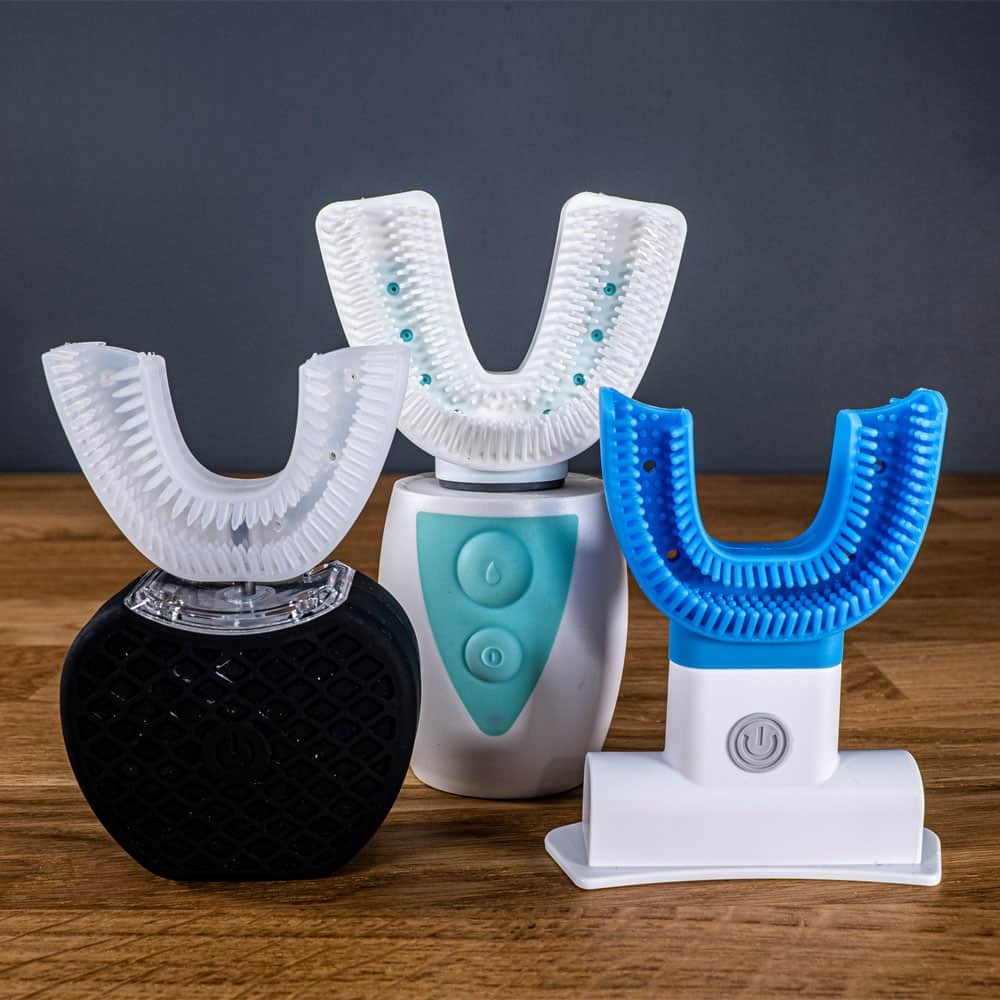
Dr Max Spicer
Dr Max Spicer, is a name that frequently appears with these types of products.
This so called German dentist is very illusive.
I have been unable to find any real dentist who goes by this name or who has created such a product.
In fact, Dr Spicer only appeared on the scene some years after the first mouthpiece toothbrushes were launched.

Dr Spicer is often associated with websites/brands and products that I have never heard of. Those same websites are often very thin on content, product details and information about the company.
Many promotional videos state how Dr Spicer innovated such a product. So proud of the wonderful new product he created, he never actually appears in any of the videos.
A reverse image search on Google turns up multiple results of what appears to be a stock image of the so-called Dr Max Spicer.
Somehow Dr Max Spicer is also Dr. Marcus Prodi, dermatologist, Dr. Steve Kimber Jr., amongst others.
Of course, if you haven't figured by now, Dr Max Spicer does not exist and the image used is a stock photo.
Jonathan Dunn & Daniel Bradford
Another 2 names often seen or used in the marketing of these types of product are Jonathan Dunn and Daniel Bradford.
Whilst we cannot rule out some involvement by people of this name, there is little that conclusively ties them to these brushes. They appear fictitious.
Often cited as the creators of the product and sometimes said to be a dentist, you never actually see pictures of Jonathan or Daniel, nor any videos talking about their revolutionary product.
It won't always be the case, but most people who create a product are keen to promote and talk about it. Therefore you see them in the promotional videos, on the website and being quoted in other media.
Dr Jim Collins DDS
Myst is a product we have called out as one to avoid. Many consumers have expressed their dissatisfaction with this mouthpiece toothbrush.
However, according to press releases Dr Jim Collins DDS is 'an authority in oral health care' and says 'The beauty of MYST is that it's mistake proof. It provides 100% coverage every time. You don't have to worry about brushing at a certain angle or getting to those hard-to-reach areas -- MYST™ XRT™ does everything for you'.
We are not sure what product Dr Collins has used, but it can't be the same Myst product we have tried.
The odd thing is Dr Collins appears nowhere on Myst's website which sells the product. If he is quoted in the press releases you might think he would be on their website too?!
We are unable to determine who exactly Dr Collins is. There is no reference to his location within the USA, his practice and experience.
The same product, different brands
Mouthpiece toothbrushes are made by a number of different companies/brands.
However, in the vast majority of instances, the product you receive is actually designed and manufactured by one company, V-White.
This is the same V-White that was tested as part of a clinical trial, where the results showed that the cleaning performance was not clinically more significant than no brushing at all!
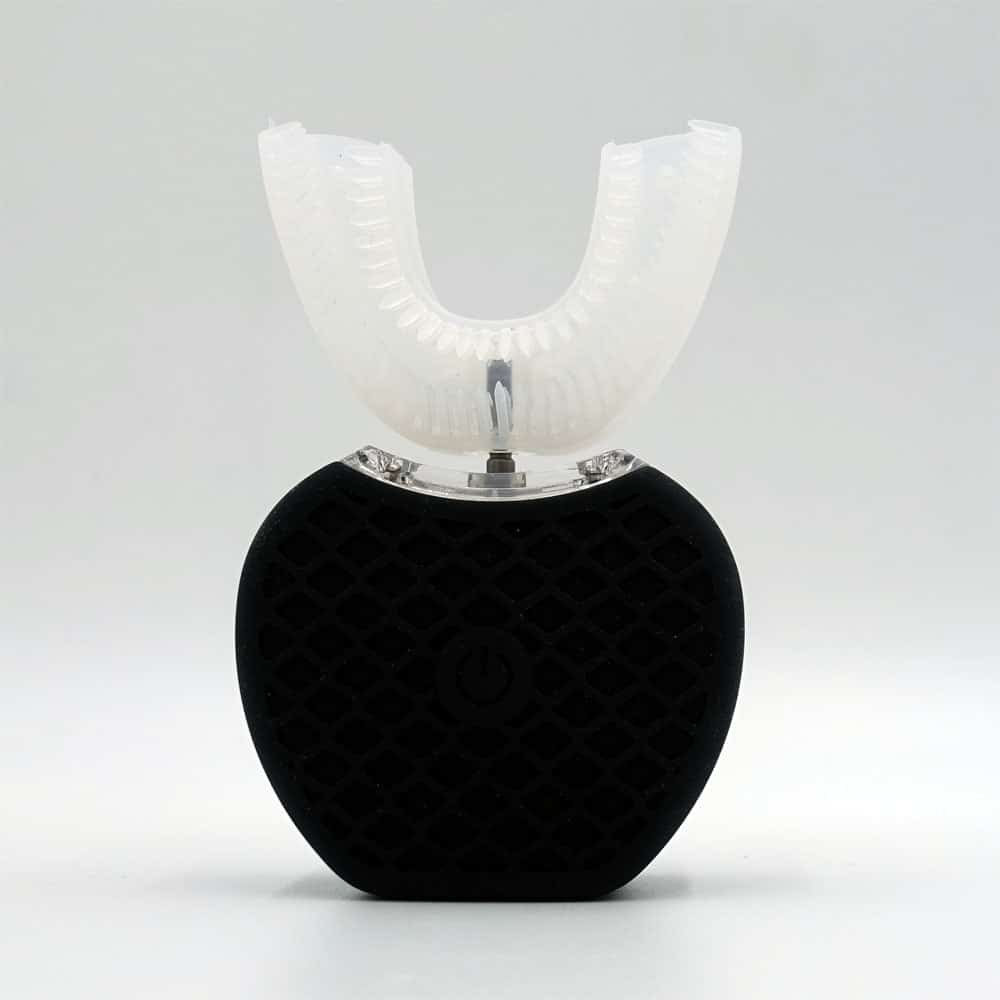
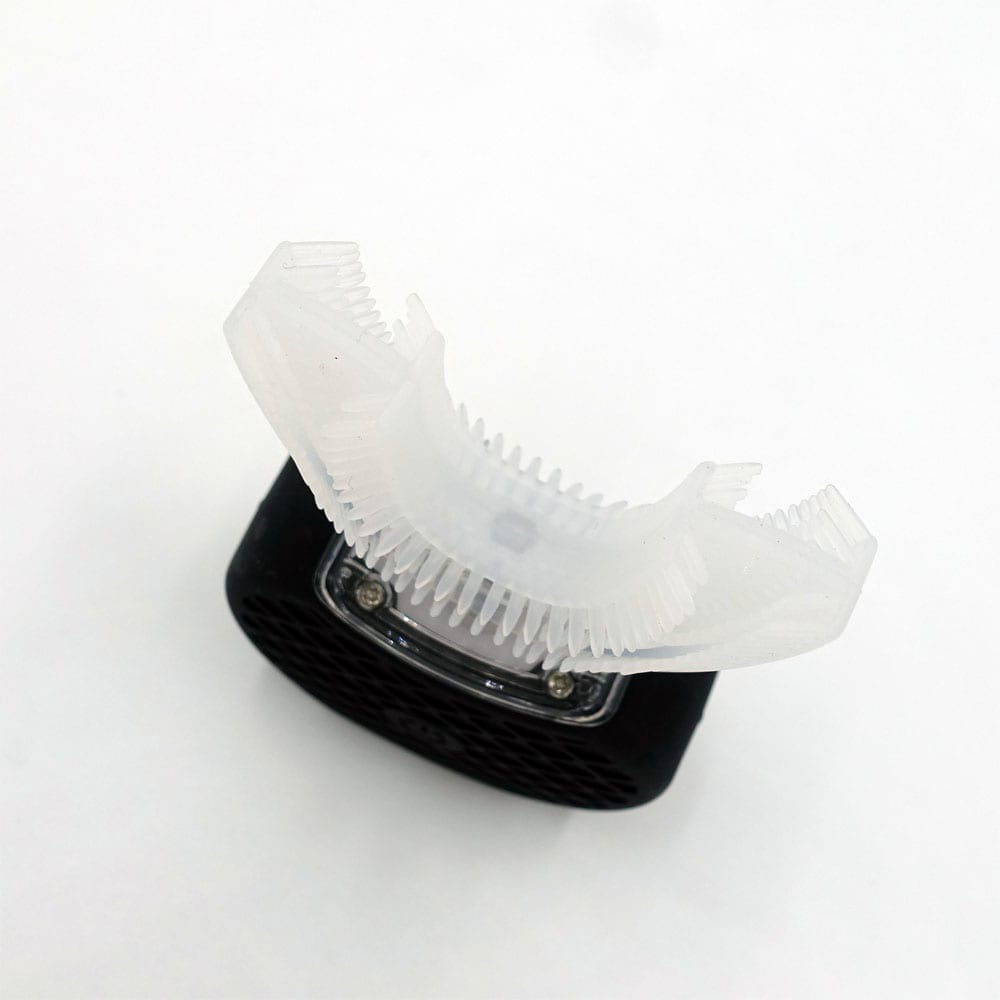
Often, the website you buy from has a name, but the actual product you receive will make no reference to this. We know because we have experienced this ourselves.
Here are a list of websites/band names that sell mouthpiece toothbrushes, but we believe what you will receive is a V-White toothbrush.
- UDental Pro
- SensePro
- Saniwhite
- Sonic Brush / Sonicbrush
- 360SonicBrush
- Ultrasmile 360 Sonic toothbrush /Ultra Smile 360
- Daplico Dental
- Ultra-Brush
- UltraBrush360
- Myst
- Go Smile Blue Hand-Free
- Sunartec 2020
- Shonker electric U shaped Toothbrush
- Bright Smile - The Ultra Brush
- CleanT / Clean T (https://get-cleant.com/)
- Happi Teeth/Happi Brush
- Toothshyne
- Supemurk - Hands-free ultrasonic automatic toothbrush
- Samolike
- BrushProX / BrushPro X
- Proteeth/Proteeth-dentalcare
- LazyBrusher
- Mr-Tooth
- HiBrush
- Nuubrush
- Dentabrush
- Decoheal Hands-free ultrasonic automatic toothbrush
- Britebrush
- WhiterUp
- Nkdsmile
- Yessmile
- Brush Ease
- Autobit
- Cyclone Brush
- JAPAN Kumamoto automatic toothbrush
- Omnibrush
- Zhonglihe 360° electric sonic teeth whitening kit
- GideaTech automatic toothbrush 360°
- Autobrush
Many of these brands will have customer reviews to help sell the product. You will see how in many images, it is the V-White toothbrush that is shown.
The following video is my review of V-White (Hibrush).
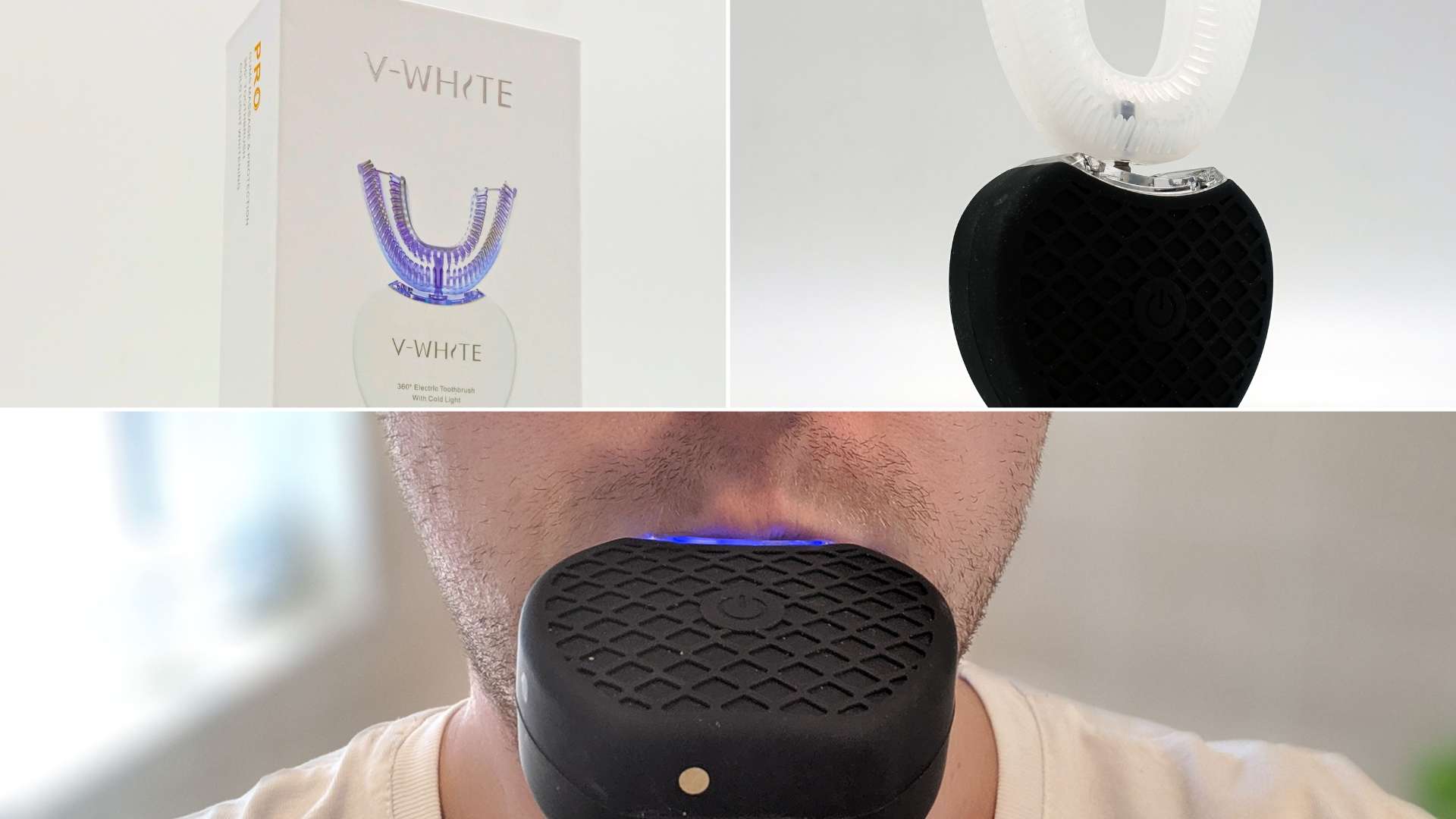
We will tell you when a product is good enough to buy
We do believe that this type of toothbrush could well be the future, but now and for the foreseeable future, they are no good enough.
SymplBrush is the best example we have tested to date. It shows the most promise, closely followed by Y-Brush.
We are continually looking for and testing new products. We read the clinical studies and analyze the data.
We do this with the assistance of highly qualified dental professionals.
Only when it passes our tests and gets the approval of our dental advisers, will we be able to recommend one of these products.
We will update this page when we believe there is a product good and safe enough for you to use. Until then, avoid them.
If you want to be notified when we find such a product, enter your email address in the box below.
Find out about new toothbrush technology
Sign up to be alerted when interesting new dental products are released — we only send these email alerts when there's a new product worth hearing about (usually every 2 to 3 months).
- Find out which products are worth buying (and which aren't)
- Quarterly updates
- No spam
Buyers guide
We have made it quite clear about the current situation with this type of toothbrush.
However, in the coming years they will likely become commonplace as technology and design improves to allow such products to work effectively.
We’ve tried to provide the information we think you’ll find most useful, without getting too bogged down in detail.
What is a mouthpiece toothbrush?
A mouthpiece toothbrush is a new style of dental health product that cleans all the teeth at the same time.
A molded component, often made from silicone, is placed into the mouth and bitten into like you might a mouthguard used for sports.
This is attached to a handle or handpiece, that sits outside the mouth. The handpiece includes the motor that moves the bristles in the mouthpiece to clean the teeth.
Whilst ‘mouthpiece toothbrush’ is one name for this type of electric toothbrush, they are also referred to under many other names, including:
- Whole mouth toothbrush
- Mouthguard toothbrush
- Auto brush
- Automatic toothbrush
- 360° electric toothbrush
- 360° toothbrush
- Auto toothbrush
- Full mouth toothbrush
- U shaped toothbrush
- U-shaped automatic electric toothbrush
- Self-brushing toothbrush
- Hands-free toothbrush
- Gum shield toothbrush
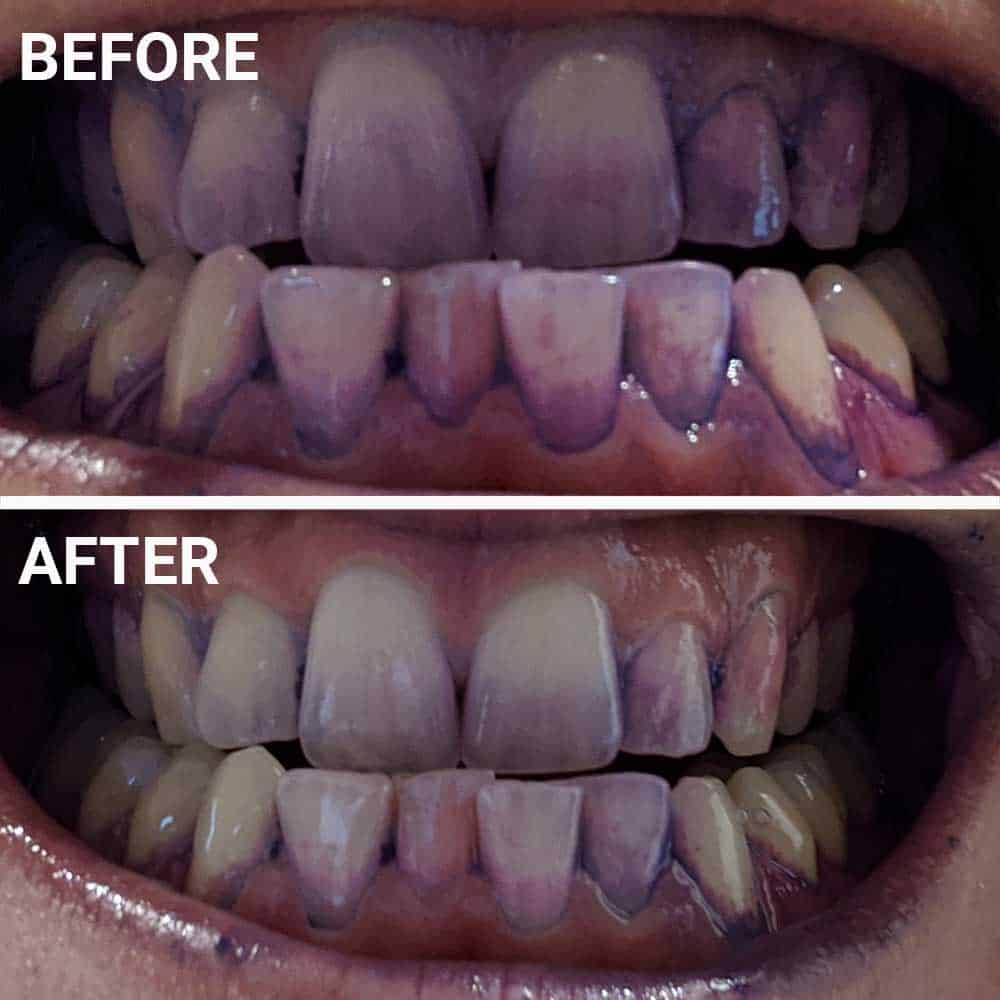
How do they work?
Each mouthpiece toothbrush works slightly differently depending on how the creator has developed and manufactured the product.
The underlying principle and theory is very similar to a regular electric toothbrush.
A built-in power source (the battery) will power a motor when the brush is switched on. The motor drives a series of brush heads/bristles inside the mouthpiece.
The bristles sweep along the tooth and gum surfaces and clean the teeth in a similar fashion to a regular toothbrush.
However, unlike a regular toothbrush, the design means that all 3 surfaces of your teeth are cleaned at the same time, reducing the amount of time you need to brush for.
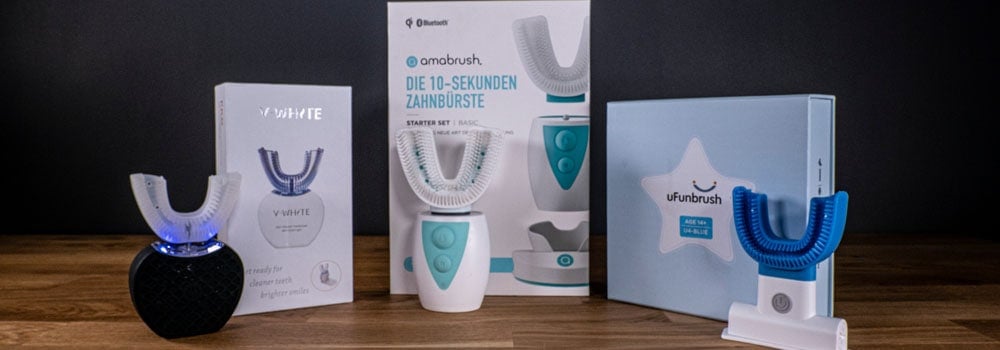
They claim to reduce brushing errors because the human element is removed
You can have the most feature-rich and capable electric toothbrush available, but if you don’t correctly position and move it around the mouth, you are not helping yourself.
Brushing for 2 minutes is one thing, but having the right technique is another.
There are recommended ways in which to brush your teeth with an electric toothbrush, but this relies on you, the human controlling the brush, to move and position it correctly to allow the bristles to sweep away the plaque and bacteria.
Despite your best efforts, there will be times where your approach is inconsistent, small areas of the mouth may be missed. It’s normal, it’s human nature.
A mouthpiece toothbrush, in theory, reduces the chance of error.
The mouthpiece is a fixed shape and size and the bristles located to reach and clean the teeth and gums.
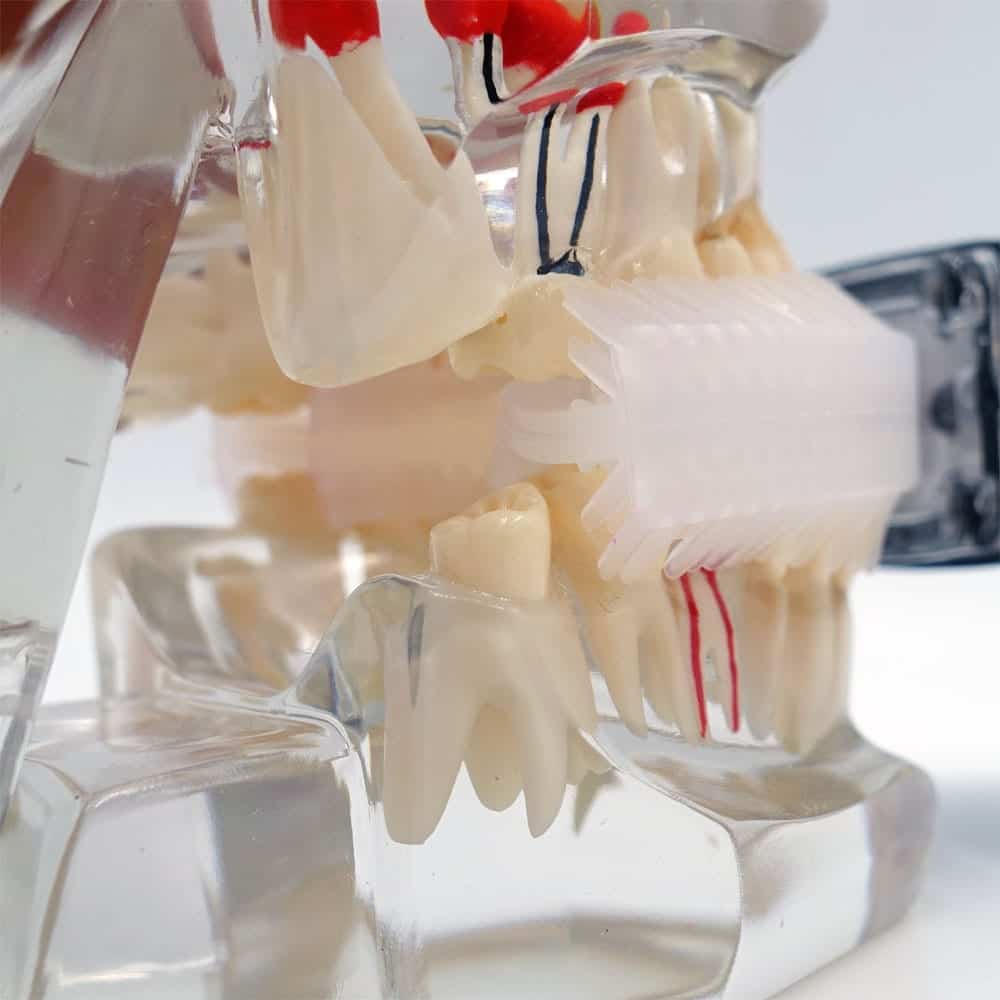
In principle, the mouthguard style brush head reduces the variation in the cleaning technique and positioning during each clean. This means that in time you can have healthier teeth and gums because you receive a better clean.
The reality of the situation, however, is that currently, no mouthpiece toothbrush achieves a standard of clean that we can even consider satisfactory. The cleaning performance is well below the standards expected.
They claim to reduce brushing time
Believe it or not, using a mouthpiece toothbrush reduces the total brushing time but actually results in each tooth being cleaned for longer.
As little as 3 seconds is all that is required to clean your teeth with a mouthpiece toothbrush, but the default cleaning time is actually set to 10 seconds in most instances.
Even at 10 seconds that is some 110 seconds less than a regular manual or electric toothbrush, every time you brush your teeth.
I could save myself some 48 days in my lifetime by reducing my brushing time to just 10 seconds.
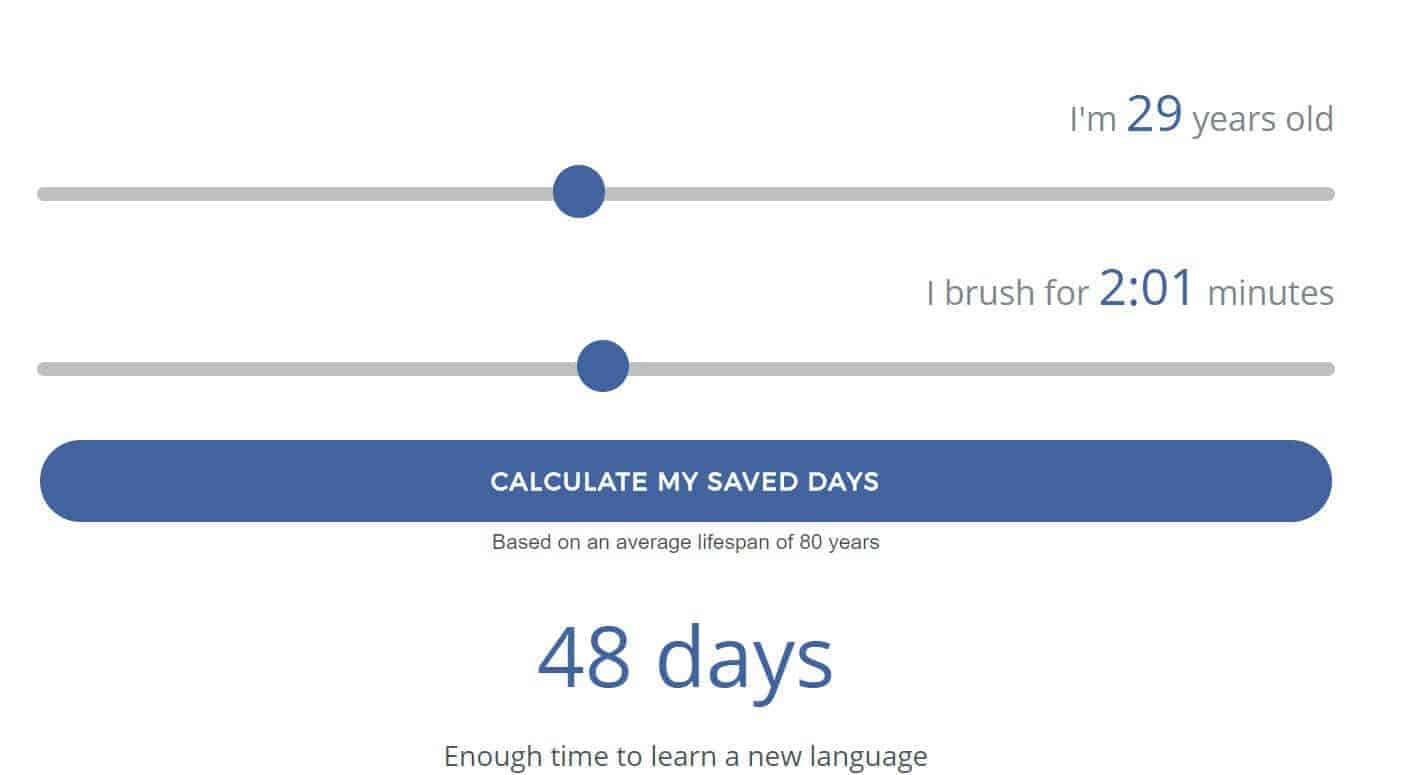
You only need look at the 30 Second Smile electric toothbrush to see how significant time reduction is possible.
The mouthpiece toothbrush does — believe it or not — actually brush each tooth surface for longer, despite cleaning your teeth for less time.
How?!
If you think about how you brush your teeth now. Although you may brush for 2 minutes at a time, you are not spending 2 minutes on each tooth, in fact just a few seconds.
The average adult has 32 teeth. Each tooth has 3 surfaces that need brushing.
With 96 tooth surfaces to be brushed (32×3) and a normal brushing time of 120 seconds, that is just 1.25 seconds per tooth surface (120/96).
The BIG difference with mouthpiece toothbrushes is that they brush all 3 surfaces at the same time.
Therefore even placing the new mouthpiece brush into your mouth for just 1.25 seconds would, in theory, be equivalent to what you do now.
However, 10 seconds has essentially become the benchmark.
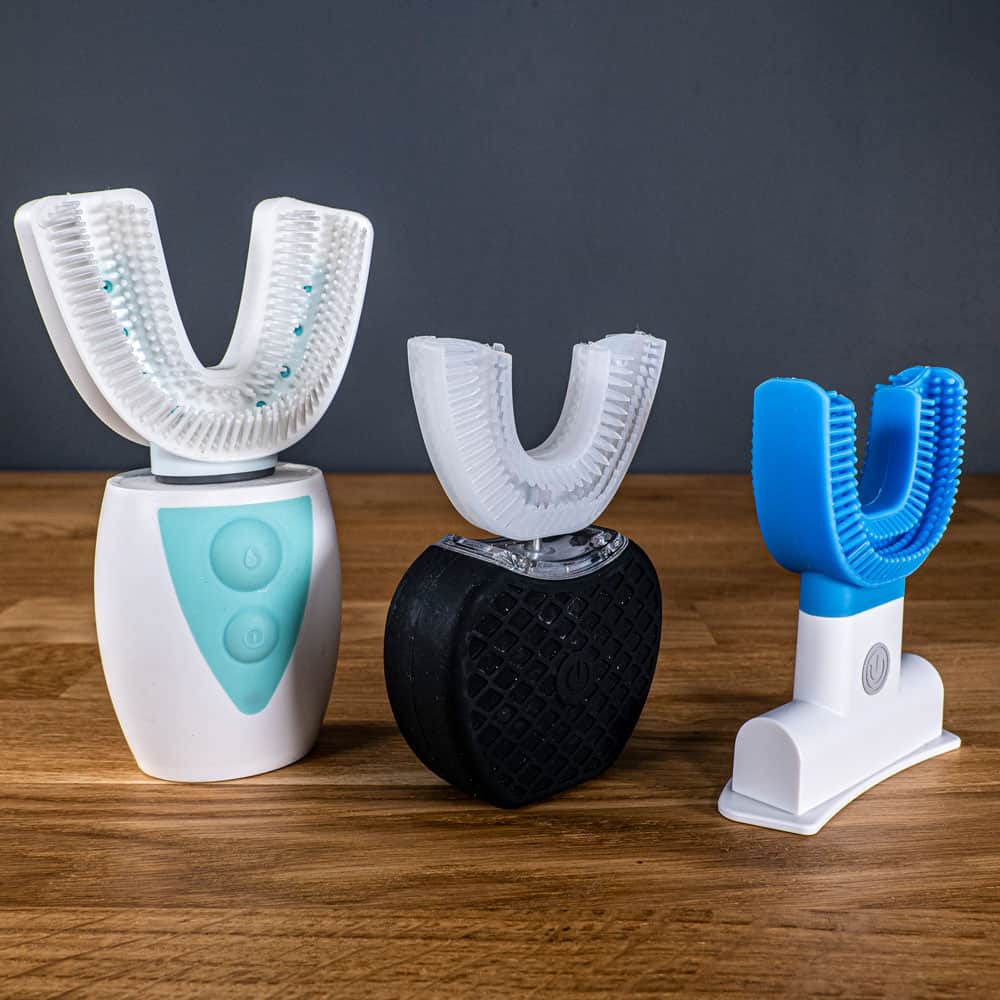
Are they clinically tested and proven?
No, not really.
A study by the Forsyth Institute with SymplBrush has resulted in some positive, results in favour of using such a product. But, and we stress, these are by no means conclusive. Much more research is needed.
Other whole mouth toothbrushes to have undergone study are V-White and Amabrush. In both instances, the results were far from positive.
Some brands suggest that they have worked with dental professionals to develop such products to ensure they perform effectively. They may well have, but to date, no brush has been given the seal of approval by our in-house dentists.
We have definitely not seen any leading dental bodies approve such products either.
As more brushes come to market, there will likely be some testing and trials that take place.
However, such trials are expensive to conduct and take time, so we do not expect to see reliable results for the foreseeable future, until a larger, better financed brand or company begins to make such a product.
Having myself spoken to many of the product creators, they would not continue with manufacturing and producing a product they do not believe could succeed and deliver beneficial results to the public.
That said, having gone hands-on with multiple products, we are a little concerned at what we discovered. A clinical trial is simply not necessary. We can tell you first hand that the cleaning experience is below the standard you would expect.
The following images show the plaque that exists on the teeth before using each toothbrush and after.
Amabrush
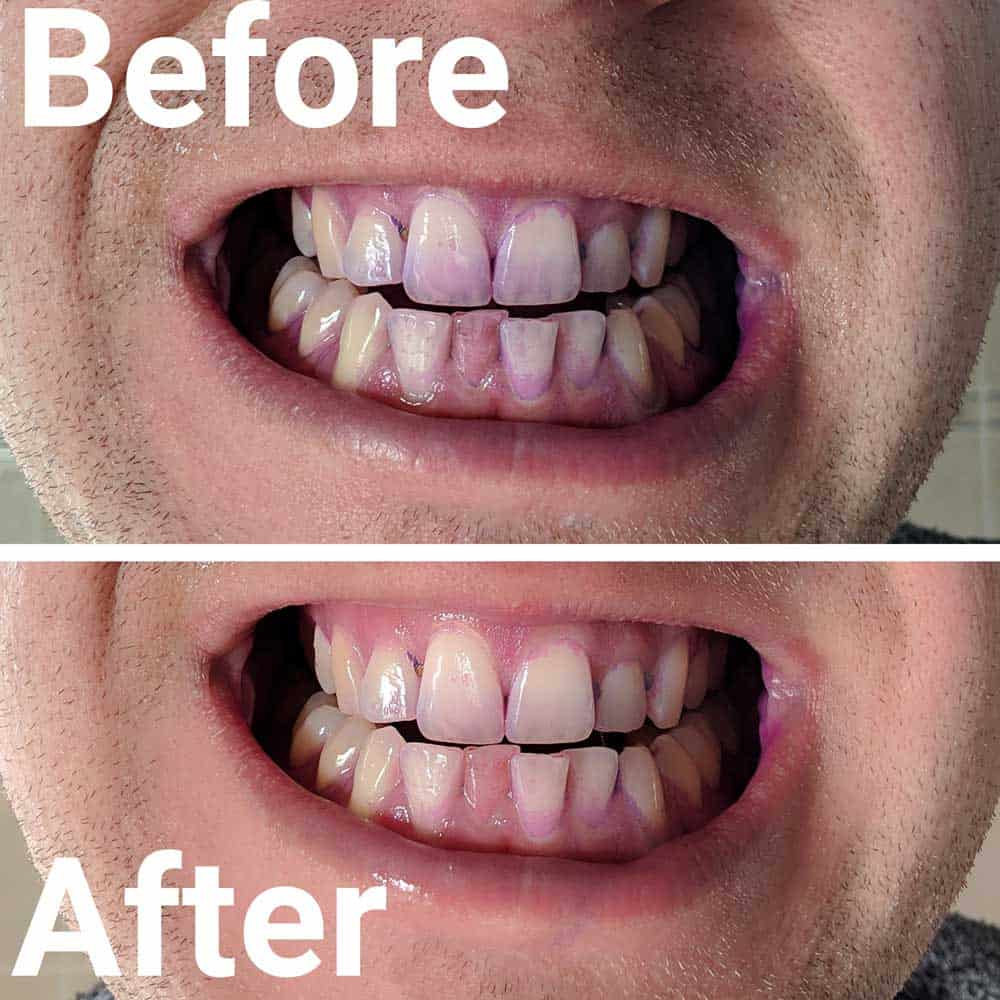
V-White (HiBrush)

uFunbrush

Y-Brush
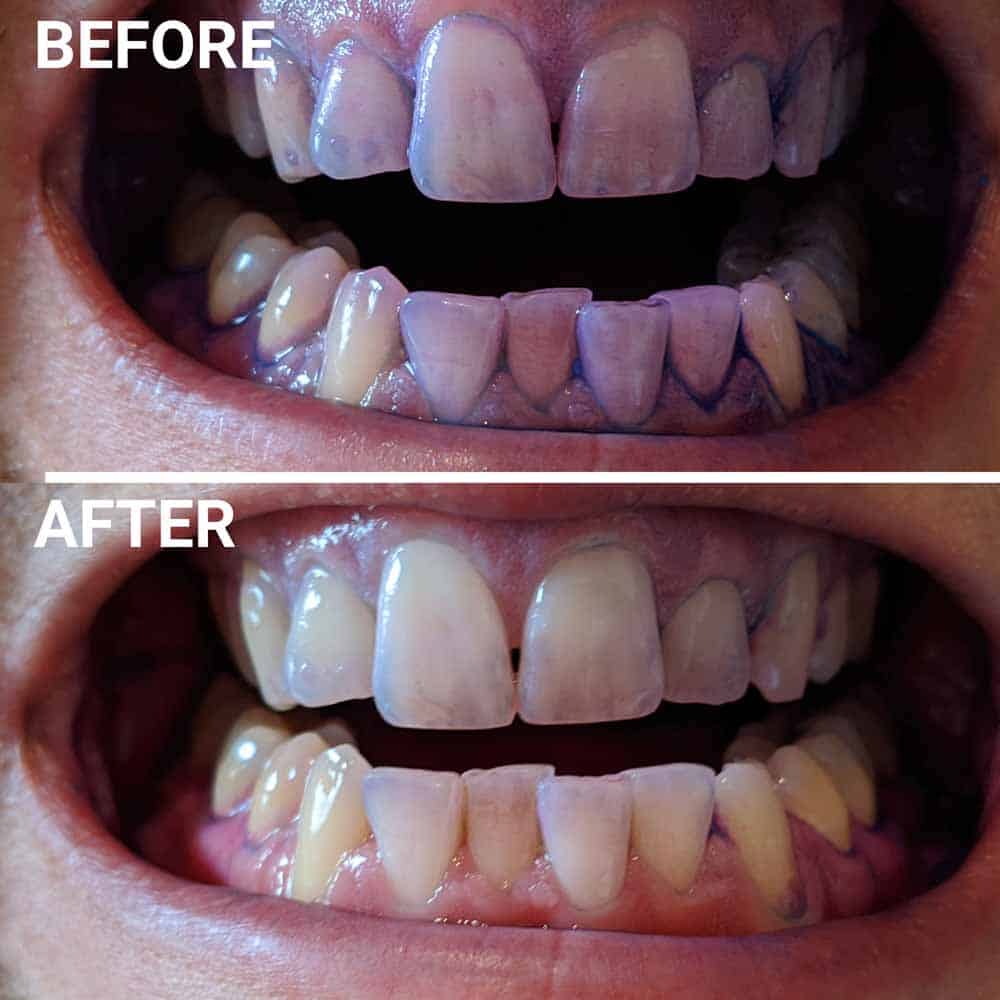
SymplBrush
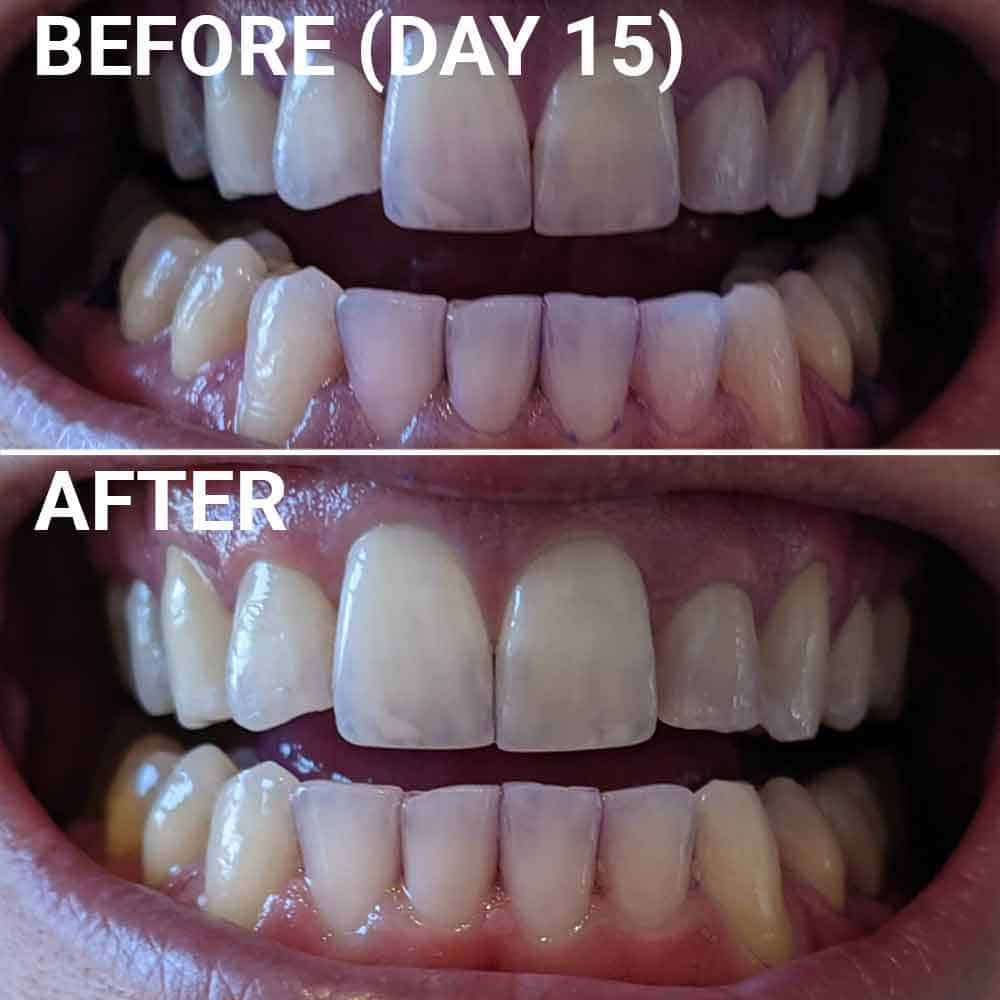
They are not better than a regular electric toothbrush
No, not if you are judging them on their cleaning performance alone. They are much worse.
However, whether something is better or not is of course personal opinion. It depends on your point of view and how exactly we judge these new types of electric toothbrushes.
Of utmost importance is the clean that they deliver.
To date, none have suggested they would offer a better clean than conventional tooth brushing methods.
Amabrush, for example, had specifically cited that their brush will conform to the BASS method which is a widely recognized approach in tooth cleaning, which shows there is a significant level of importance placed on how well the brush actually cleans.
Sadly, in reality, the molded mouthpiece does not offer a consistent and high standard of cleaning we expected. It is not yet time to ditch the manual or regular electric toothbrush.
Only time and testing will really show how good or bad all of these different brands of mouthpiece brushes are.
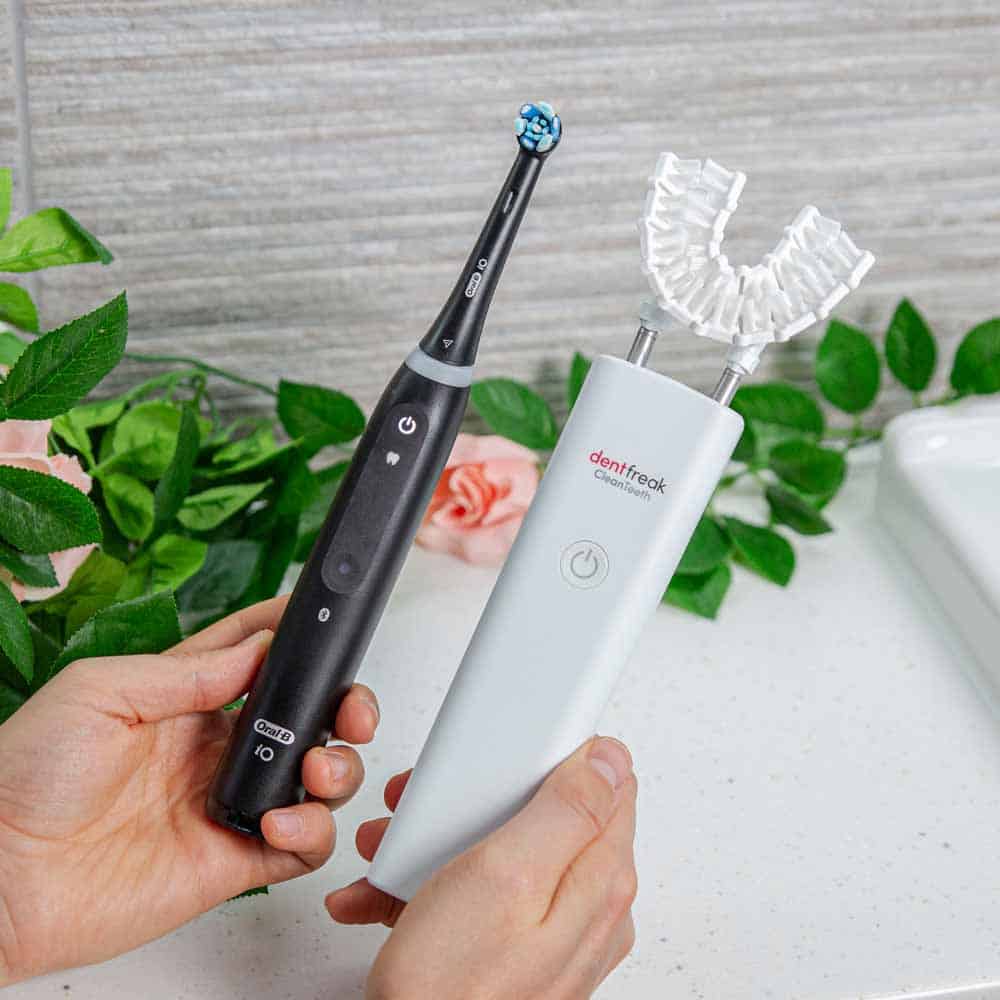
To be worth investing in, the cleaning experience needs to be equivalent to a manual or electric brush.
Of course, a big factor here is convenience. The reported time saving could be a big appeal for those that are time-poor.
The brushes are unlikely to offer up the same battery life as a regular toothbrush due to the size constraints, so this could be a downside.
Claims are between 2 and 4 weeks. Of course, this is just a few minutes of running time compared to 1 hour or more available on most regular brushes.
Amabrush did, however, last much longer in our testing.
Features may be limited — the larger handle of a regular brush allows for more technology to be built-in, but that hasn’t stopped the introduction of Bluetooth into some.
What features do they have?
At this time it is not a complete like-for-like with regular electric toothbrushes but there is an increasing similarity with features like Bluetooth and wireless charging being offered.
The core feature is the ability to clean the teeth quickly and effectively, compared to a regular manual or electric toothbrush, or at least that is what is claimed.
Most then benefit from being compact, portable and generally convenient to use.
Each brand/product has its own additional features that make it unique.
Ufunbrush, for example, is designed with the idea that children will be the primary users. Different sized mouthpieces are available and stickers can be attached to the mouthpiece to make it more ‘fun’ and enjoyable to use.
It is the only one to be powered by a removable battery.
Unico (a failed kickstarter product) was supposed to offer different sized mouthpieces as well as a modular storage system with UV sanitizer along with a smartphone app. It was also supposed to have a built-in toothpaste dispenser.
AutoBrush has different animal characters on the handpiece and plays sounds to try and better engage the child.
Amabrush radically evolved their product and range of accessories due to the high level of funding they received.
Bluetooth connectivity and a smartphone app did become a reality. A wireless charging stand, travel case, UV sanitizer and more accessories were supposed to come. The company went into liquidation in 2019 however.
Who is making them?
In 2017 there were 3 main brands/manufacturers that announced a mouthpiece electric toothbrush.
All 3 introduced and have funded their products via crowdfunding platforms such as Kickstarter and Indiegogo.
Amabrush was the first, with Ufunbrush and Unico following.
Amabrush has to date achieved the greatest level of funding, developed the product furthest and in my mind, presented the best overall package. However, in June 2019, the company went into administration.
They achieved €4,300,000, just shy of 6400%, more than their desired funding goal.
By early 2019 they have turned the concept into a reality, with many customers (ourselves included) having received working units.
Why not take a look at each of the promotional videos they created to secure initial investment.
In 2018, Y-Brush was announced and successfully funded.
It is a more serious competitor to Amabrush (now no longer trading).
By mid 2020, it was made available and we have published a video review.
Also in 2018, another product was successfully funded. Unobrush took a slightly different approach in its design, using foam for a mouthpiece.
For a variety of reasons the product evolved into a more typical U shaped style toothbrush. It began shipping in 2021.
We tested it and rated it 0 out of 5.
In 2020, a number of other companies and brands announce products, with the genuine intention to innovate within this market and create effective products. Some examples are CleanFreak CleanTeeth, Talo Brush, Willo and Encompass.
In 2021, virtually out of nowhere came SymplBrush. It is a privately funded product that didn't tease and market the product long before it was ready. The team had been working on it quietly for some time and began shipping it in the summer of 2021. Currently only available in the USA, we have gone hands-on with it in our SymplBrush review.
Come 2022, CleanTeeth began shipping and despite being a bulky unit has delivered some impressive cleaning results in our hands-on testing.
Sadly, there is an ever increasing number of companies who appear to be trying to cash in on this evolution in oral healthcare products.
At the start of this article in the section ‘The same product - different brands’ we listed companies selling these types of products.
Unlike the brands listed earlier, the following do appear to be making their own products:
- Otobrush
- Huojo automatic electric toothbrush
- Anabrush
- Anself auto 360
- Chiz toothbrush 4.0
Cheap alternatives and replicas
Hopefully, it is clear already, that currently, it is not worth buying a mouthpiece toothbrush.
WWe say this having tested what is arguably the best example or attempt at a mouthpiece brush to date, SymplBrush.
However, there are many companies trying to tempt you to buy one.
It is quite likely that you will see an advert on Facebook, Instagram or across the internet for what appears to be very cheap alternatives to the Amabrush and Y-Brush products mentioned here.
Quite honestly, from what we can tell these are just companies trying to make a quick bit of cash at your expense.
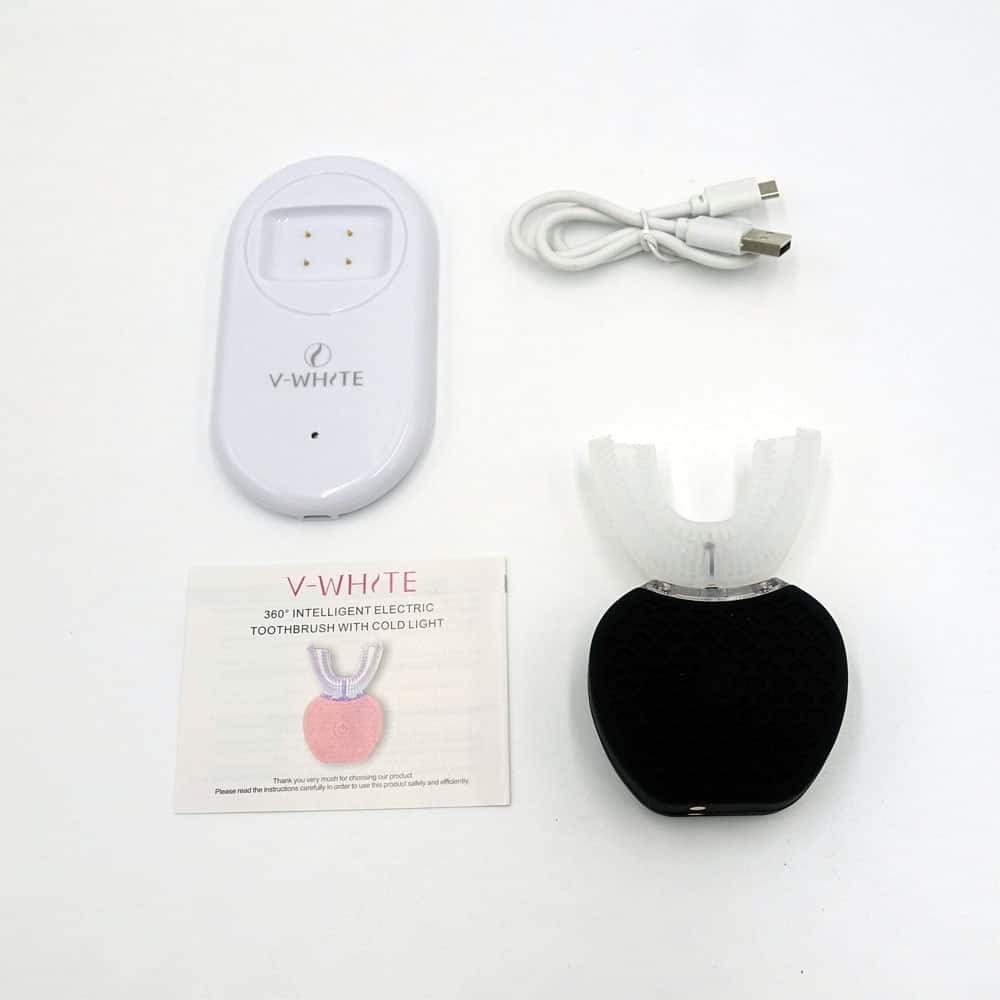
Whilst we have not tested them all, detailed research shows many are copies or re-badged versions of the same product, made by V-White.
The websites selling these are very poor with little information about the brush, how it works and what it offers. The sites have little or no information about the company who makes them, how to contact them or where they are based. Many of the reviews appear fake and overly positive.
When you actually find a review from a real customer, they generally have nothing other than bad things to say.
Some products also advertise ‘whitening’ features, which in itself is a warning sign because even if this were to be effective (which it won’t be), it’s a dangerous over-simplification.
The reality is these products are nothing more than cheap, low quality, inferior replicas/copies sold at a fraction of the price. They do not work and should not be bought.
We are more than happy to praise those that offer something generally good, but unfortunately, we have no evidence to date of any offering something that even comes close.
How much do they cost?
The cost depends on the brand you go for and the package you select from what is on offer.
Prices start from as little as $60/£45/€50 with the average starter kit being $120/£90/€100
If you are thinking that this is expensive compared to a regular electric toothbrush, then yes there is a bit of a premium to be paid, but that is necessary for the advantage and claimed innovation they bring.
From 2017-19, when you purchased one, you were usually backing the brands crowdfunding campaign.
In some instances, this is still the case, but many are now taking orders via their own websites and shipping the product relatively quickly.
There are those cheap copies mentioned above that ship instantly and can cost as little as $25/£20/€20 but can be sold at more than $130/£100/€115.
The best product to date, SymplBrush has a retail price of $189/£136/€160.
Where can I see and buy them?
You won’t see these products in your local dentists' office, pharmacy or supermarket.
Even if you did, avoid them at this time.
Because these products are being sold by relatively unknown brands, the majority are sold via direct to consumer methods, bypassing traditional outlets.
You normally have to go direct to the companies website to order it and have it sent to your home. Only then do you get to see it.
Some brands do sell via larger marketplaces such as eBay and Amazon, but again you have to order and pay for it to be delivered before you get to handle it.
What do the reviews say?
Any reputable review will ultimately tell you to stay clear of these products for the time being.
The first we reviewed was Amabrush.
We have also tested Hibrush, uFunbrush, AutoBrush (and AutoBrush Kids) and Unobrush.
None of these have scored highly.
This is backed up by comments from others online who have bought, tried and tested such products.
SymplBrush, Y-Brush and CleanTeeth have been the most surprising, surpassing expectations and delivering the best results. But, the cleaning is still not good enough to replace the regular toothbrush.
Ultimately it is still relatively early days in terms of reviews for mouthpiece toothbrushes because so few products exist. If you do see any positive reviews, really question why this is.
If you think you have stumbled on a product that is generally getting good praise, check with us or your dental professional before committing.
*This recommendation is given based on our own hands-on testing of multiple mouthpiece toothbrushes and the experiences of others we have learned of. We are not able to test every product. There may well be a product that does perform better and could be worth buying. But, given the lack of clinical data to support their effectiveness, we still urge caution.



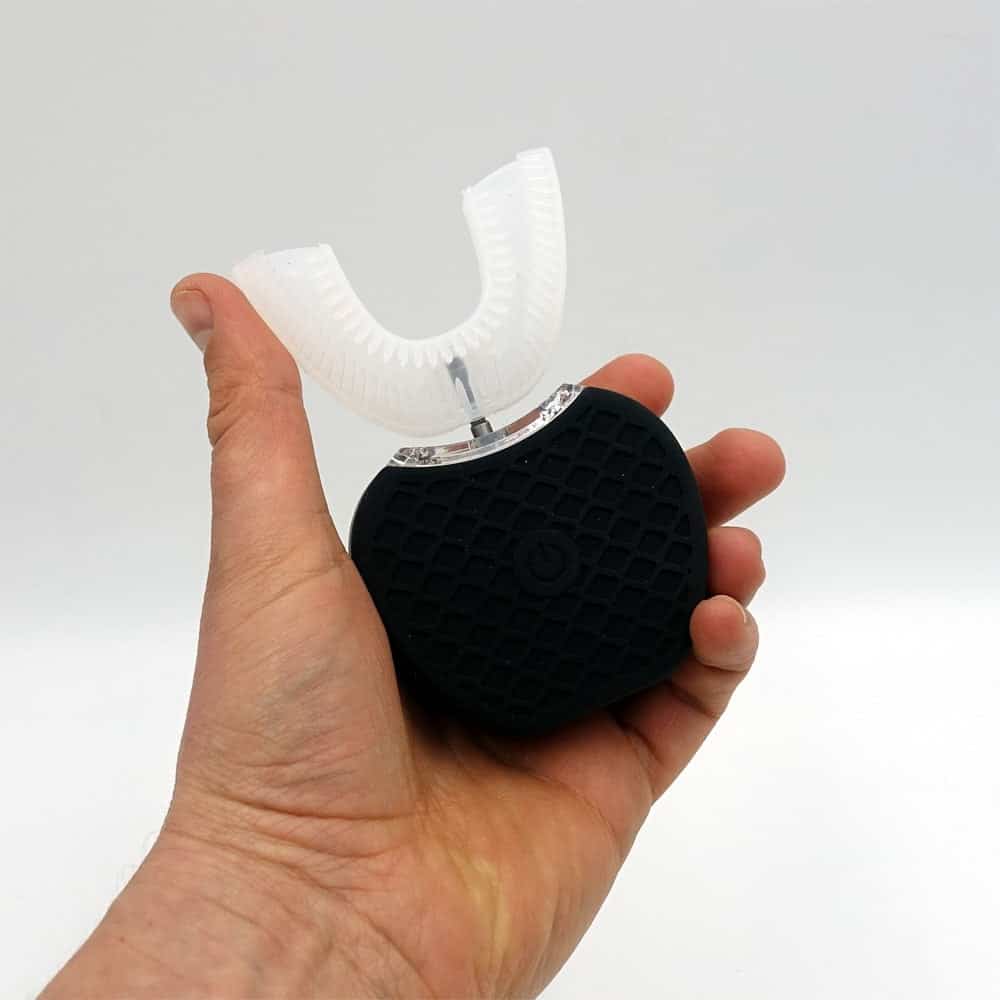
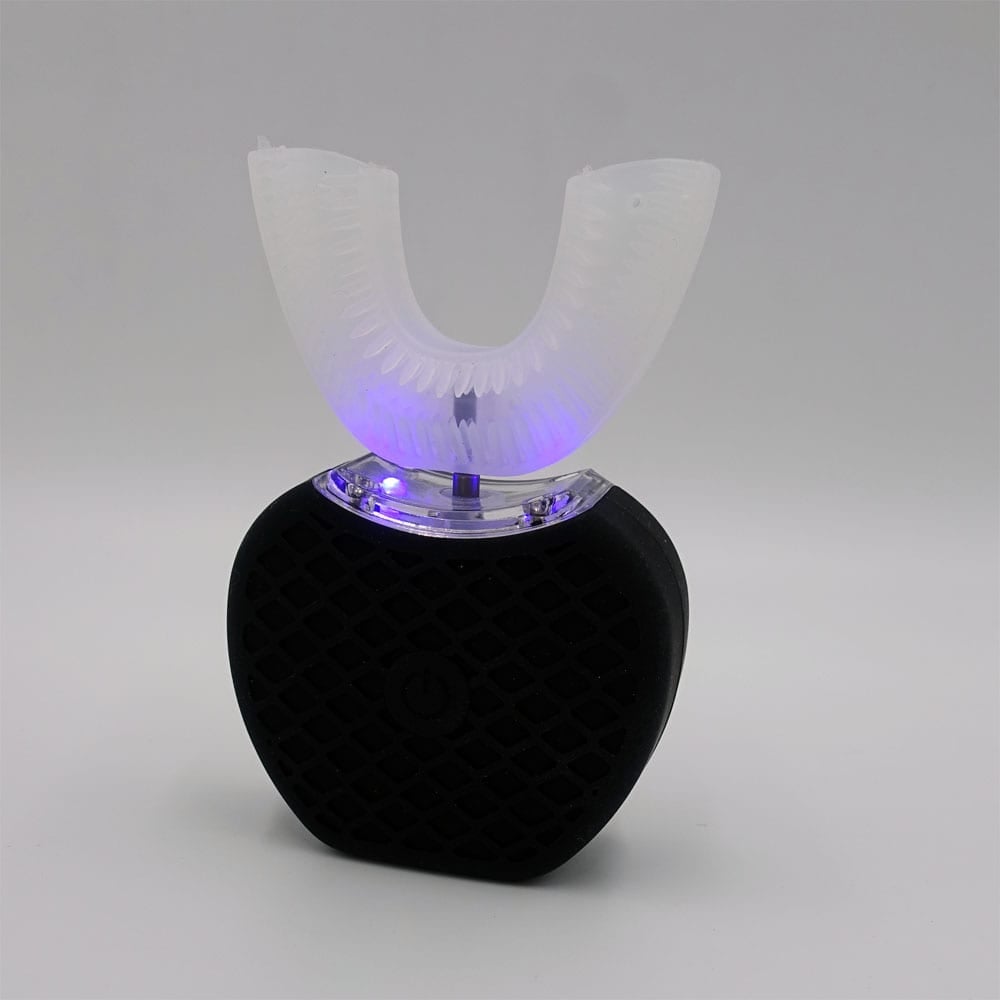
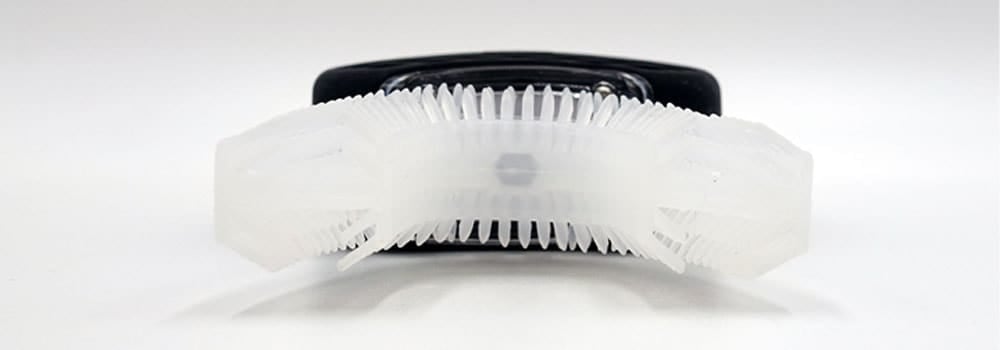
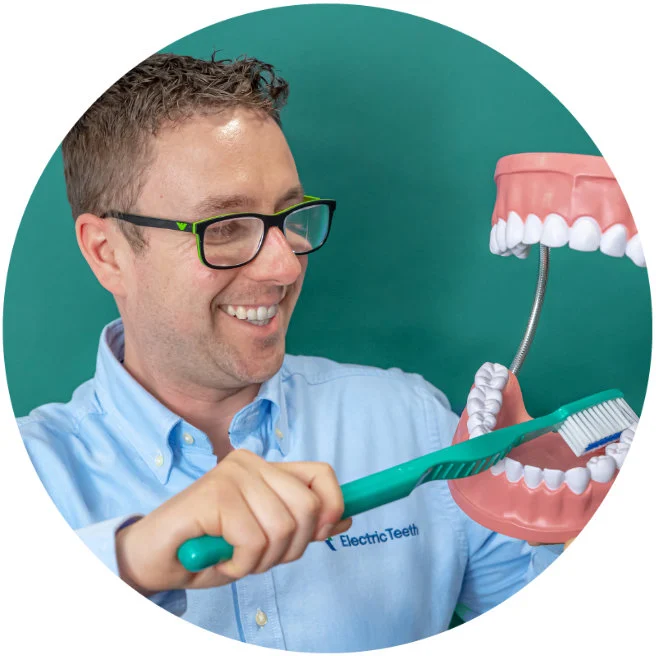
Please Keep me updated for when a hands free teeth cleaning product, that properly works is available that you recommend. That can remove tabaco stains on dental implants.
Hi Sherry. This article will be updated as and when new products come out. If you have implants, with crowns on top staining can be clenaed off with normal toothbrushing in theory. Or the most effective way is to get a cleaning at the dental office.
Yet another desperate product from China, trying to push boundaries for the sake of pleasing mum and dad, while failing to maintain any sense of integrity. Very sad.
It really doesn't matter if the mouthpiece toothbrush I'm looking for does an excellent job. Adequate is good enough. It would be helpful for people with ALS, who can't use their hands and arms very well anymore. My sister has just months, or maybe a little more than a year to live. She is completely bedridden. She is reluctant to brush her teeth anymore because it is getting too difficult for her. Can you recommend an AFFORDABLE mouthpiece toothbrush for her? We live in California so it has to be available here. Thank you
Hi Charell. We recognize that there are circumstances where adequate is good enough. Our top recommendation is symplbrush. It is the best we have tested so far. We have not yet tested it, but Autobrush has upgraded their product to have more effective nylon bristles than the silicone they have offered for some time. This could be worth consideration for your sister.
Thank you 🙏
Wow. I was looking at these because my husband throws up when he brushes his teeth. Because of that he only brushes his teeth once a day in the morning. i’m afraid he will end up losing his teeth. But I guess these mouthpiece toothbrushes are not a solution. They don’t even reach the gumline…? Egads!
Have you guys tested the Willo toothbrush? I’m curious to hear your thoughts on this product.
Hi Kristi. Willo is now available to purchase, but we have yet to test it. We do intend to review it at some point. We have intentionally delayed our testing in the hope that it will soon be marketed towards adults rather than primarily children as it is now. Willo is different from many similar products we have tested, but those alternatives haven’t yet proven themselves to be replacements to a regular manual or electric brush as documented here.
Do not purchase this type of toothbrush. I wish I had seen this article before wasting money on it. This article is correct: it is not clean your teeth. I cannot return it because I opened the box, which I did when I received it, thus negating any chance of returning the product. Besides that, it’s totally worthless.
Where can I get replacement brushes for my toothbrush
What toothbrush do you have Carolyn?
I just purchased one of these for $140 after reading the reviews at the bottom that were good and it actually just arrived today. My question is the one I purchased has a blue whitening light and a red light used to help heal the gums and keep healthy I didn't see anything about this skimming through your article anyways my question is are the lights nonsense too or do they really whiten the teeth and keep gums healthy?
In short, there is some evidence to support the use of these different colored lights. In reality, they don't work as intended and are a bit gimmicky. There is a much more detailed explanation I could go into, but basically, the outcome is the same. No dental professional would suggest using the lights found on this type of product to be meaningfully beneficial.
K thanks!
SO helpful! Thank you!!
Jon Thank you for a wonderful review, your time and patience really shows in your result. Very well done Terry Andrews
I am sorry I didn't listen to your information first. I just ordered a myst this morning. All I can hope for is that when I get it they will let me get my money back.
I would love to see ElectricTeeth test this one. They have their own toothpaste, and include 2 different trays that they claim stretch to fit. It would be great for those with disabilities if someone could get these products up to par. https://symplbrush.com/
Hi Carrie. We are aware of this product and have it on our list to test. It is not shipping yet, but be assured when we can, we will be testing it.
I’m also very curious about this product, seems different than most mouthpiece brushes, but I’ll wait for your opinion before buying! For now the 30 second smile brush is the way to go imho. Looking forward to the review on symplbrush!
Wondering about oral care a Alzheimer's. If my Mom cannot properly brush her teeth, and will not allow us to brush them for her, would the Y-brush be our best, though not great, solution? Or is there another product out there that might be better for her?
Hi Carrie. Yes, mouthpiece toothbrushes serve a purpose in cases like this where something is really better than nothing. You might find this article our in house dentist wrote useful too.
So would you say getting the Y brush would be 50/50? I was interested in the product but of course reading the reviews before hand...Please get back to when you can. 🤗
Hi Meghan. Yes, I do think Y-Brush is a bit 50/50. I would still stick with regular brushing at this time. Certainly better than nothing. My video review is available here.
Thanks for a very detailed breakdown of this product. Its one of those things you want to work so badly, but reality is what it is. Can't say I'm shocked given the type selling "sites" they popped up. Yes youtube ad, was a good draw you in "sucka" darn shame. Greatly appreciate y'all being professionals taking time to do all this, its a PSA that's saving others from likely scam. I hope you find the next great thing, cause the concept is really cool.
Mr Jon.... BLOODY GOOD to come across your website.... OMG! I have been DUPED and GOT by the counterfeit electric toothbrush industry.... I got this one thats called "MYST" XRT Technologies.... and it's DEFINITELY a Y-BRUSH... but the PROBLEM is.... i don't think the product is even REAL.... the one I got in the mail WON'T EVEN TURN ON or charge.... because ITS FAKE. THE stupid f****n charger that it LAYS on.... there is no metal plates to make a connection... PUT ANOTHER WAY: from the first time the CHARGER was ever charged and powered on, i've seen NOTHING but a BLUE LIGHT which means the thing is ALREADY CHARGED but not turning on.... THERE's a whole new kind of f***ery a-foot here: and its happened BEFORE with another type of product: made to look like a WAY CHEAP knock-off, this 30$ plastic drone.... that they sell for like 100$ to 200$, and IT NEVER POWERED ON EITHER: its called some "Emotion done" <- I know, riddiculous just the way it sounds even Hey... please GET BACK with me, and let me know how MANY others this is happenning to.... and you know.... I wonder.. are the profit margins for "FAKE merchandise" (s**t that dont even turn ON) really THAT HIGH that it's seemingly going around the industry for ANY/ALL ELECTRONIC ITEMS that seem to be "bargain deals" because the 'patent wore out' or sum S**T... ? Can't wait 2 hear from ya-
Hi James. Thanks for the comment. I don't have lots of data on how many people this is affecting, but I suspect quite a few judging by the comments here and elsewhere. Perhaps you can get your money back by raising this with your credit card provider (if you paid via this method) and they may be able to claim the money back.
A question: There are some brands of toothpaste that contain Teatree oil. The properties of this oil kill bacteria and penetrate gums. Do you think this is an advantage for healthy gums?
Hi Mary. Tea Tree oil is something that is included in some products, but it is not something that our dentists specifically call out or feel is vitally important for healthy gums.
Thanks for the breakdown. I learned a lot. Based on what I read, I’m not turned off from the idea. If honestly the concern is just leftover plaque… then I’d get a plaque focused brand of mouthwash and floss then move on with my day.
Hi Jerome, I see your logic. Plaque is the very reason we clean our teeth. A piece of floss will get the plaque between the teeth. Mouthwash might remove some plaque. But, the vast majority of plaque is removed as a result of the physical contact of the bristles, breaking and sweeping away the chain of bacteria. If this contact of bristles isn't happening the plaque remains.
I have a rotary Oral B electric toothbrush but it often irritates my gums and I got an infection which I believe from its use. Is a sonic toothbrush any better?
Hi Michael. I would arguably say they are comparable. The cleaning action is different, but the results are the same. Some people get on better with one over the other. Some dental professionals will too have their preference for one reason or another. How long had you been using it to get this 'infection'. Was the infection diagnosed by a dentist? Did they give any insight into the cause?
I have been using my Oral B electric tooth brush for about three years. I use a brush head with regular bristles but with bits of material which appear to be plastic. This is supposed to remove some of the plaque. In the last three months the brush has been irritating my gums. I had pain in my lower right jaw when I would bite down. My dentist determined that one tooth was causing the pain and referred me to an endodontist. The endodontist did a 3D x-ray scan and said that that particular tooth had had a root canal and that there was a bacterial infection beneath the root. He said that the tooth had a short post in it which was only about two thirds of the length of the tooth. He said that the root canal should be redone and a longer post be put in. He prescribed an antibiotic (Amoxicillin). That cleared the infection in less than a week and I have been pain free since. I asked how bacteria could have gotten below the tooth and he replied that it might have gotten in under a flaw or leak in the cap. I personally think that it may have gotten in through the gum line when brushing my teeth. The cost of redoing the root canal is quite high. My dental insurance (Blue Shield) pays only about a third of what is billed and doesn't pay for some procedures at all. The endodontist billed me $390 for the 3D scan and Blue Shield will not pay anything for it. I've already paid $175 out of pocket and still owe the $390. The endodontist said that I would have to pay another $450 out of pocket for the root canal because my insurance will only cover about $890 of the total cost. However, he also told me that my insurance wouldn't cover the 3D scan and that's why I had to pay the $175 (which I paid). Now I received a statement from the insurance company that shows that he billed $390 for the 3D scan which they refused to cover and that I owe this to the endodontist. I'm beginning to see this entire process and procedure as a "money pit" and I have lost trust in the dental profession as far as this one is concerned. I cancelled the appointment for the root canal and will consider this as a learning experience. I am currently using a regular tooth brush.
I was foolish enough to buy the MYST without reading the return policy. They claim that they cannot receive the product back once it has been opened. However, that really doesn't matter because they do not answer or return my phone calls. Their website, which is basically a "purchasing" site reveals a side window indicating that another person (victim) has just purchased their product. They claim that you have a 30 day return option but in a confusing barrage of print note that it must be unopened. There are very few people who will not open what they have ordered and decide to return it unopened. As far as I am concerned the "MYST" sellers are scam artists. I'll bet that they don't even use the product themselves. Why is our world so full of such people?
Mr Michael.... BLOODY GOOD to come across your comment.... OMG! I have been DUPED and GOT by the counterfeit electric toothbrush industry.... I got this one thats called "MYST" XRT Technologies.... and it's DEFINITELY a Y-BRUSH... but the PROBLEM is.... i don't think the product is even REAL.... the one I got in the mail WON'T EVEN TURN ON or charge.... because ITS FAKE. THE stupid f****n charger that it LAYS on.... there is no metal plates to make a connection... PUT ANOTHER WAY: from the first time the CHARGER was ever charged and powered on, i've seen NOTHING but a BLUE LIGHT which means the thing is ALREADY CHARGED but not turning on.... THERE's a whole new kind of f***ry a-foot here: and its happened BEFORE with another type of product: made to look like a WAY CHEAP knock-off, this 30$ plastic drone.... that they sell for like 100$ to 200$, and IT NEVER POWERED ON EITHER: its called some "Emotion done" <- I know, riddiculous just the way it sounds even Hey... please GET BACK with me, and let me know how MANY others this is happenning to.... and you know.... I wonder.. are the profit margins for "FAKE merchandise" (s**t that dont even turn ON) really THAT HIGH that it's seemingly going around the industry for ANY/ALL ELECTRONIC ITEMS that seem to be "bargain deals" because the 'patent wore out' or sum S**T... ? Talk soon-
Hello, I ordered the Myst after watching a YouTube video commercial. I haven't received it in the mail as of yet. After reading this, I don't even want to open it. Thanks for the info!!
Bought one for my husband who is bedridden and didn't want his teeth brushed but willing to try this. Don't think it does a great job but is better than nothing. Am I fooling myself?
Hi Victoria. In some instances, it could be better than nothing. However, our testing would suggest very minimal plaque is removed. In reality, just a few seconds with a manual brush is generally more effective and beneficial to the user than these mouthpiece toothbrushes at this stage. These products do pose a real opportunity for those with disabilities where movement and general ability to clean the teeth can be limited. But, they do need to remove the plaque. You might find some useful advice in our article about dental care for people with disabilities.
Yes this mouthpiece thing is total garbage. The bristles don't move and there is only a small vibration in the total device that does nothing for brushing teeth. Furthermore it doesn't completely reach the back teeth. I used it once and I hate it. it just sits there and does nothing
I just want you to know that you have saved me with this post. I have had teeth and gum issues and tyring to brush better and fix what I can fix is where I am now and this would have destroyed me and I was about to purchase a mouthpiece toothbrush after seeing an ad on YouTube, but God-willing I decided to look at reviews first and this article I feel has literally saved me... not even from wasting money but from destroying my teeth
Glad we could help.
Like others here, I'm so glad you have done a careful analysis to save us from mistakes! On YouTube I saw one of those entrancing ads for the Myst Toothbrush, and boy do they make it look good! Sad that if it seems too good to be true, it usually is. I have learned by now to do an independent search before buying, so you saved me time, trouble, and money. You do have to watch out for FAKE review sites, but I could tell immediately that yours wasn't one of those. I also went over to your article about electric toothbrushes and it helps immensely. I've been wondering if I should get one, and it's so hard to start comparing the dozens of options when you've never had one before. I will probably go with your top pic (the reasonably priced Oral-B).
Glad I could help Diane. Any questions, please do let me know.
All those with unproved quality “Ultrasonic Brush” is made in China! It is enough to say it. China steals some rough idea but never makes real effort to make it working, then just makes all inflated ad to promote them.
I’m curious to see a review of the unobrush version. It is supposed to have nylon bristles as well, similar to the y
Hi Samantha. We have one of these arriving with us soon and will be sure to update this page once the review is available. You can sign up for our emails (sign-up form on this page ^) and we will email once it has been published.
I bought the Myst U-shaped toothbrushes for my older teenaged children. The fact that this is an easier way to brush teeth was attractive to them. I’m happy that they are using the Myst instead of not brushing at all. It would be my dream they would brush for 2 minutes with an electric toothbrush, as well as floss, but that is not reality. I am not endorsing Myst, but as a mom I do what I think helps my kids the most. BTW, I agree with the anonymous post from February 11 about someone inventing rotating bristles to brush all 3 sides of the tooth at one time. Sounds like an BRILLIANT idea. I would be happy to buy those next.
I was looking for reviews after seeing an online Myst commercial. I was suspicious because the voice over, alleged to be one of the inventors, was electronic AND the voice skipped over the nsme of the product! But the idea seemed like a good one so I kept looking.. SO GLAD I found you!! Thanks for saving me $ and clean teeth!!
I have just received the myst toothbrush ordered on this shop: https://myst-toothbrush.com A friend recommended it to me and it sounds not bad compared to the others you describe. Do you think this brush can be different?
Hi Johan. From what I can see and determine from the information, it is no different and unlikely to perform as well as you would hope. Sorry to be the bearer of such news.
Wow. I am beyond shocked, disgusted, and utterly frustrated that I came across this page a few days too late. I got roped in by a Youtube ad and immediately went ahead and purchased thinking that this was the real deal. And too see someone else comment that they were given hell about a refund just makes the situation even worse. They are legit scamming folks
Hi Jay. Have you received the product or is it on its way to you?
I received it and opened the package already unfortunately
Try it and see what you think. I am interested to know. If you are not satisfied, do speak to your card issuer, they might be able to help get a refund.
Need immediate help stopping a credit card purchase of the Myst toothbrush with a fake 505 off ad pop-up on youtube! They are trying to charge me $200!!! Just purchased 2 hours ago; help me stop this rip-off, please!!
Steven. Speak to your credit card company if you paid via this method. Alternatively, if you paid with the likes of PayPal speak to them. Both should be able to help.
I also want to say that the whole idea of creating a new brushing system like this could still be a good idea, if some real dentist and real engineers came together on creating something like this in the same manner. Like actually having spinning bristles that actually rotate and oscillattte on both the inside of the teeth and the outside of the teeth all at the same time. Top and bottom teeth. Like rotating carwash bristles but for the teeth. Cause when you think about it, the idea still sounds like its a good idea but they just failed on the actual enginuity. They failed on putting in the actual hours, in an actual lab, performing test run after test run till they get it right. It looks like the materials they used to create such a cheap uneffectve product is because the cheap ineffective material being used. If they put the same amount of effert on the product like they did with creating such a simple and convincing video, they might of actually have something. Like I said, the whole concept, the idea of such a device still seems that it could be a good idea, it just needs to be really worked on and created with better material and much better enginuity. The template, the framework is still there, I think it can be improved into creating a product that actually works. I'm pretty sure when people first heard of the pneumatic tire, (air filled tires) as a better way to get around people probably thought it was a stupid air filled idea and thought it probably wouldn't last compared to the solid rubber tires that they where already use to using. But look at us now, there's not a vehicle out there that doesn't used air filled tires. My point being is that the whole idea of creating such a device to help improve the way we clean our teeth is still a good idea, as long as there's no means to fool the public for a profit, then it can really be made with real improvements and real results. People always say there's no reason to re-invent the wheel, when in reality re-inventing the wheel is what we have been doing since the wheel was ever invented. The wheel didn't start off as means to carry around loads much more easier and faster till somebody applied it into that concept. Don't get me wrong this specific product looks like it sucks and you have proved it, but the idea behind it still has potential for someone to actually improve it or make it really better than the toothbrush can be obsolete. Look what happened to DC current when AC current was introduced. We still use DC current it's just AC current benifits us all. Still always room for improvement.
Damn that was a close one. I was watching the ad and thought to myself it's about time we evolve on how we clean our teeth. But as soon as i typed in the Web address on a different device the browser was showing that it could not find that Web address. I was going to order this product or at least look at the website with my mind set on the fact that i was already going to buy it. So I type it in the Google search and luckily one of the results that came back from the search was your warning. So I clicked on your link thinking you guys where the competition just hating on this new product. I got to say after reading what you said and reading the many other disappointed people who purchased this piece of shit quackery product, I Just want to say that THANK YOU SO MUCH FOR DETERING ME FROM MAKING A REGRETTABLE AND STUPID MISTAKE. THANK YOU AND GOOD LOOKING OUT FOR THE INNOCENT TRUST WORTHY CONSUMER BYSTANDERS LIKE MYSELF. THANK THE GOODNESS THAT IS STILL LEFT IN THIS WORLD THAT THERE IS STILL GOOD PEOPLE LIKE YOURSELF TO HELP OUT AND NOT LET PEOPLE'S VUNERABILTY BE TAKEN ADVANTAGE OF ESPECIALLY AT THE TIMES WE ARE IN RIGHT NOW. I'M JUST HAPPY TO KNOW THAT THERE'S STILL GOOD PEOPLE OUT THERE WHO ARE JUST LOOKING OUT FOR THE OTHER GOOD PEOPLE OUT THERE. I REALLY APPRECIATE THIS. THANK YOU.
Glad we could help. 👍
I’m very confused! https://awesomejelly.com/myst-hands-free-toothbrush/
Frank I understand your confusion. Whilst I cannot confirm, I suspect that the article has been sponsored/paid for. The article goes into very little detail about the product and really showing how it works or the results the users got. It is to the opposite of what I and most others have experienced. Seems a little odd...
Thank you for this information on Y toothbrush and your honestly.
Jon, What is you opinion on products such as the waterpik? Thank you.
Waterpik products definitely serve a purpose and on the whole are good products. We generally recommend interdental brushes and/or dental floss as the primary tool for interdental cleaning. But, water flossers like those made by Waterpik can be great additional tools to help with this task of cleaning in between the teeth. They are also an option if you really are never going to use floss or interdental brushes. Ultimately they have a place. I would avoid the Waterpik Sonic Fusion and the Waterpik Whitening water flosser. If you need any more information, please let me know. You may find our water flossers guide useful.
This is a great forum and saved me from getting one of these brushes based on a compelling Ad on YouTube. Thanks to all here!
I got trapped into the myst infomercial and I stupidly bought it without doing research and of course the first try I noticed it didn’t clean my teeth whatsoever, I even did 4 cycles... still a filthy film on my teeth were left. I asked for a refund and they have been giving me every excuse from they can’t except it back because of Covid to sending me these generic terms saying just by clicking on the website I agreed to the terms themselves, both of them I called them out on because I said for one they were hiding behind Covid because it wasn’t like they could resell it.. it’s a toothbrush! And second the just by clicking on the website you “agree to the terms” which are not even listed anywhere and doesn’t even mention no money back etc. they’ve offered a 50% refund and I said no I want a full refund, they’re selling a defective product and I sent them the link to this website to show them they aren’t hiding. I plan to wage war against them, they’re stealing money from people at a time when people can’t afford it and risking their health and dental care.
Were you successful in getting a refund? I too purchased and am not happy but I have not requested a refund yet. I plan to call and request but if you can give me any ammunition I can use, that would be appreciated.
I’m very confused! https://awesomejelly.com/myst-hands-free-toothbrush/
Hello I also bought a Myst toothbrush off an infomercial . Tried to return and they too gave me same COVID 19 excuse . They have money back guarantee if your not satisfied but how can you know if you can’t even open the box . This company is built on A COVID -19 excuse , how convenient for them smh . I hope people read this and NEVER PURCHASE their products . I’m sorry you had to go through this and I share your frustration.
Hi Desriee. I am sorry to read that you got taken in by the adverts. But pleased to read that you are doing what you can to make a difference and ensure others don't get fooled into buying one either.
Thank you. I just received another email back from whoever is replying to me, I have a feeling it’s a young person set to just run interference. I got sent the very same email as before. So they’re playing games, I’m going to call my credit card company and go that route because I am not taking only 50% refund. I so appreciate your website with all this information.
continued: I bought mine from Myst.
Do you have any suggestions on how to return one of these y-shape brushes. I just received one in the mail today, 01/14/2021. I should have seen this beforehand...
Try contacting the company, but more often than not they don't reply or refuse the return. The more effective option is to speak to your credit card/payment provider through whom you made the payment and they can often issue a claim/chargeback and get your money back for you. No guarantee but worth a shot.
I got a question.... how is it JUNE first of 2021 and this MYST company is still in BIZ ???? THE COMPLAINTS on HERE go BACK to DECEMBER of LAST YEAR......... WTF... I thought sum a yous was "waging war" against this company. come on... they're still youtubing their S**** right NOW even
Hi Mike. It does surprise us a little but unfortunately today it is very easy to market to people and have them buy the product. Many don't question the adverts and believe everything to be true. We would love to stop them, but we do not have the means to do so. We do our best by putting out this information for free for all to see and hopefully learn from.
Jon - we must rely on those of you who review and post honestly and with “love” to expose these scams since prevention is not possible. The OTC supplement Prevagen that the FDA finally fined its manufacturer about for falsely claiming it improved memory thru jellyfish extract is glaring. Preying on seniors, the company sniffed at the fine, added the usual fine print no one reads - but kept the large ads about curative props - and right back on the shelf it is, along with hundreds of 4.7-star ratings. (It works so well elderly folks can’t remember the FDA issues and buy it!)
What about the MystSmile brush that has no bristles? Its supposed to break up plaque with about 5k vibrations per second.
Mike, I too purchased this product after watching a YouTube ad and I hate I ever bought it. I received it in the mail yesterday, used it this morning...followed by my electronic toothbrush. I still felt the bag of gummy bears I'd eaten last night stuck on my teeth after using it.. The absolute worst thing I've ever bought online.
Hi Mike. I have not come across this brand before. A web search appears to reveal a company offering the same style mouthpiece toothbrushes as I speak about in this article. I would be wary about any purchase. I see no reference to not having bristles. Do you have a link or website that you saw this on?
Hi Jon, thanks for the quick response. You are right, the website that the YouTube ad redirects a prospect to doesn't mention bristles or sonic cleaning. http://buymystnow.com/ The initial advert doesn't mention bristles only the 5k vibrations per second. However, they may have skipped over the fact the toothbrush has bristles to make it seem more "revolutionary". Interestingly, the advert does mention a dentist by name who teamed up with a product engineer (also named) to create this innovation. If I get retargeted by the same ad, I'll try to record and send you a link.
Thanks for sharing Mike. This is the same website I came across. The dentist and engineer story is very familiar and ficticious.
Yes, I bought one. The short ad on youtube sucked me in, pun?! Anyhow, I paid about $100 including shipping. I used it for a few days and it did not seem better than my sonic toothbrush, so it got retired.
I was hosed by this product recently, received mine in the mail, and purposely didn't brush my teeth the morning it arrived. After receiving my 360 Sonic Brush and Tooth cleaning foam, I gave it a try, and to my surprise, it was like a mouth guard, that was too big for my mouth, and the bristles barley move while "cleaning" your teeth. After about 2-3 minutes I stopped, rinsed my mouth, and could still feel the scum on my teeth. The only thing I could see this being used for is a quick clean after a meal to make sure nothing is stuck in your teeth, as it can remove lose food, probably, pretty easy. Other then that this is a worthless product and should not be purchased. Save your money and get a Sonicare, as they actually work and clean your teeth.
Thanks for sharing your experience Chris, even if it is not the most positive. It is very valuable to others reading this.
Thank you! This is what the internet it supposed to be about! Pros and cons! I'm doing research now and found this wonderful review!
So informative. Thank you very much for saving me some cash.
Jon, these Y-style toothbrushes sound like a fantastically good idea --- if they only worked! They are intuitively appealing, which is why the one on kickstarter got 6400% of the funding it initially asked for. Maybe if they had actual toothbrush-style bristles, they'd work better. I saw an ad on YouTube for the CleanT and it boasted an 'ultrasonic' feature---another good-sounding idea. Yet the ad had some giveaways that it was hokey---no actual dental professional endorsement; claims that "brushing (with a conventional brush) CAUSES tooth decay, and a bizarre computer-generated "voice" of one of the "creators." In principle, they're plausible and appealing. In reality, well, I'm glad you did actual testing, and thank you for doing that. The US Food and Drug administration and dental professional bodies ought to issue statements advising against these products. Have you thought of contacting them and urging them to do so?
Hi Jeremy. Thanks for the comment. I definitely agree with you about them being a good idea, if they worked. You are correct in saying that those with nylon bristles like a regular toothbrush would likely work better. We have seen this with a product called Y-Brush. Although better there was still scope for improvement. Although the thin nylon bristles are proven to be effective, it is quite possible that other approaches can work, if implemented correctly. Time will ultimately tell. I am aware of CleanT and as you suggest it all sounds a bit suspicious. It is the same as the V-White product I have tested. I actually recorded a video on our YouTube channel advising people not to buy it. In many respects, you are right about the likes of the US Food and Drug administration putting out statements about these products. I have not actually thought about contacting them. I don't think they would do anything. The reason being as there is that fine line between encouraging innovation and the capitalistic world we live in. They have to be very careful about what they say. It can potentially be hard to call our particular products without expensive testing. Perhaps they could put out generalized advise/statement, but that does not always grab the attention. Even then, these messages need to get in front of those that will actually be considering buying this sort of product. All being well some, like yourself will do the research. Dentists could undertake a more proactive role in making the general public aware of such products and the potential risks they pose. But, I think they would argue to some extent it is not their job. Plus, by making some aware of these products, even highlighting the risks may cause more people to actually consider them?!
I was one of the first to order the Amabrush when the kickstarter got launched. After one Year of waiting I finally got it! I was so happy. But then, I tried it and got pretty mad. How can they sell a product like this? The moment you turn the device on you know it doesn’t work. I mailed them to get my money back but obviously that was not possible because of the terms and condition of kickstarter. So I did find something that could work, i looked it up on youtube. It’s not automatic but it is a mouth piece brush. Blizzident is the name. Very expensive and would not advice to buy it but it looks like it works. All the other mouthpiece brushes have silicone bristles, but blizzident has nylon bristles i think. What do you think, is it worth a try?
Hi Gerrit. Thanks for the comment. It was a real shame about Amabrush. You didn't need to be a dental professional to tell it simply did not work. It is amazing they did actually ship it, but at least they tried, albeit at our expense! We are aware of Blizzident and it is a very unique product that is not only expensive but involves quite a process to actually get one made in the first place. I haven't actually used the specific model you are referring to. I do believe anything with nylon bristles is going to work better. Those mouthpiece toothbrushes I have used with nylon bristles have been more effective to date. From the conversations, I have had with one of the Blizzident team they are moving away from this product, and instead pushing people to their tooth cleaning sponge that I have just reviewed here. It is a manual tool and really quite interesting. It is expensive, but the results have been better than expected.
After seeing an advert for an electronic toobrush on YouTube in June 2020, in a reckless COVID moment, (unlike me) I purchased a toothbrush advertised as UltraBrush360o for £79 with a lifetime warranty (£12), which was not obvious in the sale until after I bought it! When it arrived, I noticed that the name had changed to 'VWhite' and it worked! However, when I put it in my mouth, it did not clean my teeth! After two days, I could sense the tarter was growing and my breath getting stale and I had a bad taste in my mouth. Total rubbish! I have just seen another advert on YouTube using the same formula, but this time it is called Clean T. Thanks for your confirmation that it is all a money making scam. I have left a review on Amazon re. VWhite which they published, even though I did not buy through them. So don't buy any of this type of product folks!
Elaine. I appreciate you sharing your experience, even if it is not a positive one.
Thank you so much for providing this information! Deceptive ads like this should not be allowed! I saw a CleanT ad on youtube and thought it was a genius idea, and now, not so much :)
Thank you for providing the only truthful and useful information I could find! I saw an ad on YouTube for CleanT and thought it would save time and effort but as it is hard to know what is legitimate, I searched for reviews and the other sites did not seem authentic - they were either obviously connected to the CleanT site or there was just the occasional incorrect word or use of English. While that would have been enough to stop me ordering it, thank you very much for not only confirming that I should not buy it, but also providing all the details on how ineffective these products are, so I am not left wondering if any of them might be effective.
Hi Maria. Thanks for the comment. Very pleased you found it useful.
Have y'all tested the CleanT yet??? We just heard about it. It seems to have come out after you wrote this article. Thoughts?? Thanks :)
I have not personally tested this, but it is included in my list to avoid. Everything points to it actually being a V-White product, which is not recommended.
I purchased one. Big mistake. The 30-day money back guarantee is a falsehood. They finally gave us a $20 refund for me to throw it in the garbage. The thing is not pleasant to use, does not fit over teeth, gums are exposed. Do not waste your money.
Whilst I am disappointed to have to read this experience you have had, I appreciate you taking the time to share your experience so that others hopefully don't suffer in the same way. Thank you.
Mouthpiece electronic tooth brushes may have a place in nursing homes for debilitated ,arthritic, and people suffering from dementia. People without these handicaps clearly do not need a new gadget to clean their teeth on a daily basis. Promotion os gadgets like this is comical in my view. I have been a dentist for 40 years. Give me 5 minutes or less to hands on demonstrate how to properly use a quality manual toothbrush . 90% will turn their oral health around and achieve healthy periodontal health. . The other 5% are a mystery. One of my clinical instructors in dental school said "teeth are not for everyone".
Thanks for your comment Ed. Agreed these new type of toothbrushes certainly do have a place in nursing homes and for those with disabilities, if the cleaning performance can be improved. Nothing beats understanding the basic techniques on how to brush and practicing such twice a day!
Would you please direct me to real quality reviews,like yours, on electric flossers. I have huge hands so string floss is impractical.. I end up with sore TMJ and muscles.. Reach made a battery powered flosser that used the same U- shaped flossers their manual flosser used. Walgreens and other like stores also sell a similar battery powered flosser, but the thickness of the floss is too large for my tight spaces. I ended up epoxying a Reach flower head to the Walgreens head. The motion stayed the same but with the thinner floss it was usable. Is there a guide to techniques when using either a handheld or battery powered flossers? I have discovered 6 techniques to clean each tooth. Angling to focus on the 4 corners at the gum line and up the side of the corner and perpendicular to the front and back. I do a lot of detail sanding, that's where addressing the total outside surface (minus the top) with a strip of sanding floss reminded me teeth flossing techniques should be similarly focused. Is there a battery powered flosser you recommend? BTW: I usually floss for 4 to 5 minutes ( like the handle is a violin bow held with index and thumb playing the "Softly Cleaning Waltz"). Then I brush teeth (all surfaces) for about 4 minutes. Then about 2 minutes brushing the roof, insides cheeks, upper and lower sulcus, then the tongue brushing/scraping until there is no stuff on the scraper and no white stuff (what is that stuff?)
Hi Charles. You are a very diligent flosser and your oral health must be outstanding. I would suggest you are potentially spending too long flossing and cleaning the teeth. You could probably knock a minute off the brushing time and the flossing. You don't have to if you feel that is what is necessary to get your teeth clean, but you are potentially gaining diminishing returns for spending so long and could potentially be verging on the overbrushing. That said, I and your dentist would rather you take this much time than being at the other end of the scale and not cleaning for long enough. I would happily point you in the direction of quality reviews on electric flossers if I knew of a reputable source. I have done a few reviews of flossers, but most of my time has been dedicated to the toothbrushes if I am honest, so I don't have the same database of product reviews for flossers. Battery flossers are few and far between. Waterpik do make a power flosser (available on Amazon: https://amzn.to/3hTDk0c) but its not quite the same setup to what I understand you have. Oral-B made a product called the hummingbird, but that has been discontinued with no replacement. With flossing there is less need for a powered version, for most as the important bit is the string floss actually making contact with the teeth. Preferably in a 'C' shape, so the floss is essentially cupping the edge of the tooth. Here is a video demonstrating regular flossing: https://www.youtube.com/watch?v=rm5oAAeoEnI To be honest, it sounds like you have mastered this. Have you considered something like this GUM product https://amzn.to/35X2oRS that you could attach your own floss to and use to make the process a little less difficult but enjoy the benefits of not being all fingers and thumbs in the mouth? I am not sure if threading this would be impractical for you? As for the stuff on your tongue, its a mix of saliva and bacteria. The tongue has a pitted surface and traps debris and bacteria just like the gums do. Not cleaning the tongue correctly is often the most common cause of bad breath (halitosis), so that white stuff is just a mix of all that! I hope this helps.
There is another one it appears on the matcket, going by "CleanT" even having a website marketing it as The Original cleanT.... It keeps getting advertised on YouTube. I too had doubts and have done nothing about this although 'sounds' great. The designers have surnames Bradford and Dunn, one is Daniel Bradford. One of them purports to be a dentist or working in that field seeing patients with bad teeth. They claim device cleans all teeth in 25-30 seconds. I could not find Daniel Bradford on a search even in connection with CleanT, Sounds too good to be true, so on this occasion I go with NOT TRUE. Have you heard of this one too?
Hi Justin, Yes it definitely is too good to be true, your judgement has served you well here. We have heard of it — it is included in the list we have towards the beginning of this post, although the list is so long now you can be forgiven for not picking it out. There are so many versions of the same product that keep being rebadged and then falsely marketed. If you want to find out if / when there is a product like this worth buying, you can sign up for our email alerts here.
Dear Jon: I am writing to thank you for your research on these scam U-shaped toothbrushes. I'd like you to know why what you do is so important. I was diagnosed with Rheumatoid Arthritis when I was 13 yrs old; I am now almost 60. The RA has settled into my hands very badly over the last 8 years or so, rendering them quite disfigured and very painful, especially in the mornings and again in the evenings. It is often literal torture to brush my teeth at these times, but I do it. It is less painful on my hands to use a manual brush but it takes 4-5 minutes to brush thoroughly & properly. I can brush in 2 minutes with my electric brush but the vibrations hurt so much it often makes me cry. I also try to use my Waterpik as much as my hands will allow. Regular dental cleanings are unavailable due to Covid-19 so I am relying on my hands to keep my teeth & gums as healthy as I can. Then I saw an ad on the internet about this product called 360SonicBrush - "The Worlds First 360 Automatic Cleaning and Whitening Toothbrush" What hooked me was where it said: TOTALLY HANDS-FREE teeth cleaning. I read this ad over & over praying it was true; I got my credit card out. Then I read the ad a few more times and decided I'd sleep on it. Today I checked around on the internet and saw a lot of different ads for similar products and they were basically all the the same. Same product, same hype, same 4 and 5 star ratings with exactly the same comments. I so badly wanted this piece of crap product to be true, even with the $149.99 price tag attached to it. Luckily, the very next page I found was your page, proving with complete certainty that this product is a scam. The research you had done and the accompanying pictures left ZERO room for doubt. I'm a smart woman (PhD) I knew it wasn't true but I needed so badly for a device like this to BE true, so I was willing to ignore the warning bells going off in my head. You, sir saved me from a somewhat costly and very embarrassing mistake. Please keep doing what you are doing - the internet & the people on it, need you! Thank you so very much!
Lisa. Thank you ever so much for your detailed comment and I am truly touched that you have valued the content I have created so much. It is for people like yourself that I really do hope that in time these products become the future and I am convinced they will, it is just a matter of time. If you haven't already, please do sign up to be notified about new products as this way you can find out about them from me and the team here knowing that the information will be factual. We will only ever recommend or endorse something if we truly belive it works.
thanks for the warnings would it work any better with use for 4 or 6 or 10 minutes???
Hi Loren. I believe the short answer to be no. I can't say I have tested one for as long as 4-10 minutes per session. I have tested 10 second brushes for 2 minutes, and the extra plaque removable was marginally better. But still far worse than a regular manual or electric toothbrush. The clinical study included in this article used the V-White toothbrush for 2 minutes and still came to the conclusion that it was no more effective than not brushing at all. If it can't clean the majority off within the operational time set by the manufacturer, longer brushing is really unlikely to make any difference. I would then argue what would be the point if you have to brush for longer than a regular manual or electric.
When I see an ad claiming a doctor endorses a product, I like to check if this “doctor “ is qualified in the area of expertise the are backing. Being skeptical, prior I have found people Holding a doctoral degree in philosophy or administration research backing medical products or environmental claims. Hmmmm Today looking in to “Dr Max”I found your brilliant website, well done! I loved the comparison with plaque disclosing tablets. I’ve done this after brushing with a normal toothbrush to improve my technique. Hint to readers who love their teeth; the hand you prefer brushing with will often miss some plaque on the 3rd 6th teeth on the same side. Once again thanks for a great article.
Thank you Luka for the kind words.
I clicked the add, countdown timer, free postage and half price, $157 Australian dollars! I then googled it to see if it was a good price. I see other sites selling same for $57. Australian dollars. Great I thought, going through a few stores, I then click on your link. Thank you Thank you! You have saved me $$ and disappointment! There way they go about advertising does work extremely well in trickling us to purchase. I'm so pleased I clicked your link. Thanks again, and I'll keep using last centuries teeth cleaning devices!
Its an absolute NO! Mention has been made that Spicer is German and Australian, today I saw a clip where he is described as British. I can find very little about him - in fact the reason why I am here is that it was second on my search list. There are a range of other clips with the same music, same colour and style of text for a vacuum attachment, air conditioning and, I think, glasses. The claims are pretty similar (the air conditioning industry hasn't changed in 100 years either). There are basic spelling mistakes. All of this seems very dubious. Even if it was a reasonable type of product I would steer clear
I got an ad for "Irish" dentist Dr. Max Spicer – I would suggest we have fraudulent advertising on our hands!
Thanks so much for this article and all the research that went in. (as an extremely skeptical engineer I got a Youtube ad for the "Dr. Max Spicer" one, already forgot the name-- but with the same exact stock music in these similar ads for some-kind-of too good to be true camera drone I was getting 2 or 3 months ago. ) By the way, isn't a waterpik probably the best way to clean your teeth? I used to have one, my mom threw it out. Maybe you need a brush, too. For 3 years I only use a $7 to $10 spinning/back-and-forth electric one, oral B or CVS brand I think this time.
Owen, I am pleased your skeptical nature allowed you to find this article and realize things are not what they might seem! Hopefully I have saved your teeth and some money for you! Waterpik water flossers are one type of product that can be used in conjunction with a regular toothbrush to clean your teeth, but I would not suggest the best way on their own. You don't need expensive tools to achieve a good basic level of oral care and hygiene. The best thing for your oral health is your routine. Brush twice a day, for 2 minutes, floss once a day with the correct technique. With this, you are off to a good start.
Hi Jon,I can't thank you enough for your review. I was very nearly suckered in by the advert on Facebook.I use an old Braun Sonic (with the toothbrush shaped head) that i have changed batteries to make last longer as i really like it. I was also advised by my dentist to use a Waterpik flosser,which i can highly recommend. Thank you once again for the great review.
Thanks William for your kind words. Please to read you found this helpful.
Please post a before and after using a manual toothbrush and an electric/vibrating one. It would also be useful to see this done for both the recommended 2 minutes and then the amount of time a typical person actually brushes for. It seems the problem these whole mouth brushes actually solve is they are an improvement over how people actually brush, which is less than the 2 minutes.
Hi Adam. I just want to let you know that as per your suggestion I have updated this article with images showing before and after shots of my teeth using different brushes for different periods of time. I might not be your typical user, but it should give a very good idea.
Hi Adam, thanks for the suggestion of what to add to the article. I think this is a very good idea and something I can and will do. 👍 I have previously completed these tests myself as part of my testing to compare products, but I have not taken the before and after images to share on the site. It will take me a couple of weeks for me to go through this cycle and be able to update it with these images. Whilst these toothbrushes do aim to solve the problem of how people actually brush (for less than 2 minutes) the results I have experienced still suggest that using a regular manual or electric toothbrush is better. The mouth brushes are not fitting to the teeth and gums correctly and the bristles are not cleaning away the plaque well enough.
Interesting. I just saw an advert for UltraBrush 360, created and endorsed by the *Australian* dentist, Dr. Max Spicer - not German as others have seen. If that doesn't set alarm bells ringing nothing will. Thanks for the article, you saved me some money I think!
Thank you. I have seen advertisements and was seriously considering one of these. I will follow you to see if the cleaning power of these improve. Again;, thank you.
Thank you for your really useful article. I watched Ultra-brush promotion on you tube in Japan. They said this product developed by Dr Watanabe and sponsored by Tanaka. But no Asian person seen on this program. This kind of products are really harmful to dental health. I hope more people may find your website.
hi Jon Thank you for your very extensive review / reviews. I just watched a Swedish ad about UltraBrush and in this ad they claimed 1. we have lower costs due to not using paid ads 2. UltraBrush was developed together with very famous Swedish dentist Dr Leon Olsson (if my memory is correct) When I read your review it seems V-White had a German dentist. Hehe, it seems these ad companies are lying big time then. AND on top of that contradicting themselves as well big time when the ad I watched came from YouTube and YouTube is never free of charge to use for advertising. I just wanted to send you this info. thank you Jesper
Thank you Jesper for sharing, all of this feedback is very useful. The marketing approaches around the world do vary and it is interesting where these brands localize adverts, using a 'claimed' Swedish dentist, presumably to appeal to those who live in the Nordics.
Hi! Good info here Jon. Thank you. I was wondering about the Y - Brush and how it is any different than the others?
Hi Denise. My Y-Brush review will be going live later today. I will let you know when it is available so I can share my verdict with you.
I was initially intrigued by the claim of the Ultrabrush 360 being "ultrasonic". However ultrasonic means greater than audible (> 20kHz) and the maximum frequency claim I could find in any of the products was 48,000 vibrations/minute (only 800 Hz) which puts it in the category of "sonic" like most other electric "sonicare" toothbrushes. Nevertheless there does seem to be a category of real piezo-driven "ultrasonic" electric toothbrushes with product names like Smilex, Emmident and Ultreo that require a special toothpaste that enables the "cavitation" effect of expanding and imploding microbubbles that is standard in ultrasonic cleaning baths. I also see there is such a thing as an ultrasonic scaler that some dentists may have for removing plaque at a very localized tip (alternative to manual scraping). Do you have any comments about such true ultrasonic toothbrushes for home use?
Hi Jonathan. Pleased to read that you have done your research and discovered the so-called 'ultrasonic' mouthpiece toothbrushes are well, no ultrasonic! There is indeed a category of true 'ultrasonic' toothbrushes that exist. They are not as mainstream as typical sonic electric toothbrushes and in full disclosure I have yet to undertake any extensive testing of these to make honest comparison. I will be doing so in the future. There is evidence to suggest that they are effective and I have no grounds to doubt this, but the number of options are limited and the price tends to be more expensive than a regular sonic toothbrush. Whilst they can provide benefit according to the data, the reality is that these, just like regular toothbrushes require correct use by the user. Many people don't actually brush their teeth correctly, so the benefits really don't really reveal themselves. When used correctly a regular manual or electric brush provides a more than satisfactory clean of the teeth. Going ultrasonic will have limited extra benefit for the extra cost etc. I hope this helps give some insight. P.S. Stay away from dental scalers as not used correctly these can cause damage. Best leave scaling to the professionals.
It is a pity that advertising promises and customer reviews can no longer be believed at all and that the advertised products are only ever sold and advertised to enrich the manufacturers. It seems to be likewise completely all the same to these whether they cause damage with the lies with bona fide and trusting buyers or not. This greed for money is horrible and in my opinion it is often already fraud on the customer. UltraBrush 360°: https://ultrabrush360.co citation: "Ultrabrush - the breakthrough ultrasonic toothbrush that is safe and healthier for teeth and gums (and I tested it!)" I found your site by chance when I saw the promising application of "UltraBrush 360°" in a commercial on YouTube today. This is supposed to be a new product with additional ultrasonic cleaning, which I unfortunately do not see listed here yet. But I think that I should still keep my hands off it to protect my teeth. Maybe this reference to this "tooth cleaning device" is interesting for you after all, even if it is perhaps only suitable to complete your negative list.
Thanks for sharing. From what I can see this is just another re-branded v-white product and won't clean the teeth well. Stay clear for now.
Im interested in knowing when one of these new U shaped toothbrushes become available that meets your medical approval. Please put me on that list!
Thanks Randy, I have added you to the list. You will receive an email from us, please click the link in that email to confirm you wish to receive the updates.
Two questions for you: 1) Can you show a before/after picture from a regular manual brushing as well as one from a 'standard' electronic bush, to contrast how they are better than the current crop of u-brushes? 2) Have you heard of or looked at the Ultrabrush? It claims to be ultrasonic based, which maybe is new in this type of device? I'm not convinced from looking at the two websites I found for it, so would be interested in a professional's opinion. https://ultrabrush360.co and https://ultra-brush.com are two sites I found that seem to be the same thing, though one of them does mention the "Dr. Max Spicer" that you already tried to research, so I'm fearing this one is, like the others, not what it is made out to be.
Thanks Jon, Just for fun, I will bet that out of all the names for this type of toothbrush, people will ultimately adopt "hands-free". At least in the US. That's what drew me to the whole thing. I'm glad for your insight. I also really like your term "mouthpiece", as that certainly speaks for itself. Also nice touch on the "Confirm you are not a spammer". A simple but effective way to thwart a nice chunk of spambots.
how about ultrasonic ones
An ultrasonic mouthpiece? I think this might just be a name rather than actually being ultrasonic. Have you seen one specifically?
Please, let me know if you ever find a mouthpiece toothbrush you can recommend. Thx.
Will do David. I have recently received and am testing a product called Y-Brush. This could be the answer, but I don’t want to speak too soon. More testing needed. Watch this space. I will be posting a clear update as soon as is possible.
Thank you for your insight. I was very close to buying and testing such a mouth tooth brush but I'll heed your advice and wait.
Any updates yet? I saw one called go-smile that you haven’t reviewed yet. It seems intriguing, and the reviews are hit or miss. It either works great or it’s horrible. Nothing really in between.
Hi Jon. I had not heard of go-smile. Having looked it up, I am sceptical as to whether it would be any better. Whilst I can't say for sure, my money would be on it not performing as expected. Aside from that, there is little in the way of updates. I have just received Y-Brush, which I am testing. Initial impressions are that is performs better than most others, but still not to the standard expected. However, more testing to do. I will update this article as soon as I can.
Thank you for your time on this. With all this information and part of the work done it would seem a better product could be developed. I’m a designer and a very lazy brush and flosser. As well as a tool nerd. Also have genetically poor and sensitive teeth. Was hoping for a magic bullet and of course it’s a novelty/gimmick/scam item. My voyage was: Saw an ad and went to amazon to see if product was cheaper than $60. Then saw all the knock offs and read some reviews. Then googled a product one of the reviewers mentioned as “great” and found you. This is an easy way to figure out any product validity if it seems gimmicky. This one did not pass sniff test.
Im interested in knowing when one of these new U shaped toothbrushes become available that meets your medical approval. Please put me on that list!
Noted Fayanna. We will try and update you once we know.
Thanks for this article! It sure saves people a lot of time and effort. I also found out something else about all the “5 star” reviews. On the website of Ultra Brush and Sonicare (which are almost exactly the same websites by the way!), if you click on the reviews you can clearly see that most images are EXACTLY the same but with DIFFERENT names and texts!! So that shows that ALL THEIR REVIEWS are FAKE!! People be aware, and do your own research so you will see it with your own eyes! Too bad I can’t post the screenshots I took on this comment section.
Hi Nina. Thanks for the comment. This is something we had noticed too.
Hi There, you can also precise that this piece of sh*t is made in China
Saw this on YouTube I was interested as it seemed like a sound idea. Some of the footage in the ad seemed like stock footage, and the silicone bristles seemed too large for cleaning properly. But it's a new product, so I went to checkout www.brushprox.com, and I was met by the first scam giveaway. ***THE MAIN PAGE*** When I clicked on order button, the site had a fake loading bar noting that they were checking warehouses for availability. To prove it was fake I opened the browser dev tools and saw that no related outgoing and incoming web traffic was shown. They weren't checking anything. The second sign of a scam on this page was when I clicked on the "Contact", "Terms of Use", and "Privacy Policy" links on the bottom of the main page. All three of these links pointed to the same address "https://www.getbrushpro%20x.com/contact-us?qty=1" Which isn't a navigable URL. "%20" is a space and spaces aren't allowed in URL names also why pass a quantity. "qty=1" ***THE ORDER PAGE*** This page kept showing a ticker every 5 seconds that others (e.g. Nathan S. from Blue Ridge, etc.) were buying the product. I watched those for a while, and names and cities stated to repeat. I went away for an hour to do something else, came back and refreshed the page, and the same "people" from the same "cities" were still "purchasing" the product. One of the the tickers said this product [BrushProX] was in high demand and a their best selling product they offered. It was the only product offered on the site? This website was hastily put together and full of errors, and even lies about checking warehouses. So I did research for actual reviews and came across this web site. Wanted to warn others to avoid this scam, and how they can spot scams in the future. Hope this helps :)
Andrew. Thanks for the detailed comment. You have explained and confirmed many of the same thoughts and experiences we have. At this stage such products are best avoided.
Recently, I purchased the Autobrush for my kids, it goes for 30 seconds with just regular kids toothpaste. And I'm satisfied with it, otherwise my kids would barely brush for 10 seconds at the same spot and just spit the rest of the toothpaste out. I go ahead and brush with a regular toothbrush for 2min.
Hello, I saw a Highsity whole mouth unit on sale (last day, 50% off ... gasp! Lol) at $29.99. Long commercial at 2:30 minutes. Looks as though it works, yet I am cynical about anything sold online on Facebook. I'm glad I found your website. I'll wait until something more legitimate comes along. Thank you. Paul in Minneapolis, MN P.S.
Thanks for sharing Paul. You have every right to be cynical. Save the cash and check back here in the future. We will update when there is a product that really is worth investing in.
Literally in the middle of watching the ad, which turned up while watching YouTube. It looked suspicious, so I paused it and googled the doctors name. I had an inkling the doctor didn't exist. All I can find is his own website for this gadget, but any renowned doctor with an invention would have peer reviewed scientific coverage in medical/dentistry journals etc. They would back their claims with relevant references and as a very minimum their credentials should be on a LinkedIn profile. Nothing turns up. I am sticking to brushing my teeth with a tooth brush. Thank you for your coverage of this gadget and the "doctor".
Sarah. Thanks for the comment and interesting to read that you have come to the same conclusions I have.
Just checking in on this because it was published awhile ago. Are there currently any options on the market that either seem to be or have been clinically proven effective? Thanks
Hi Julia. No, I am afraid not. There is a product called Y-Brush, which we have on order and is due to be delivered soon. This could possibly be a 'better' option, but we will have to wait and see, I am yet to be wholly convinced. There are certainly none that have been proven clinically effective.
Your article stopped me from buying one of those. Thank you. Just wondering how before-after pictures would look like when an electric toothbrush is used
Hi Tuyen, Thanks for the comment. Glad it was helpful. I don't have an image to hand to show you how they would look after brushing with an electric toothbrush. But, all the purple dye that is shown on the teeth in these images would be gone. Essentially the teeth would be clean and free of plaque.
Would a "sonic" electric toothbrush clean teeth better than an "ordinary " electric toothbrush? I'm considering changing my Oral B to a Philips. Is there any difference?
Phillip. This is a great question. The short answer is no. Essentially, both a sonic toothbrush, like those made by Philips Sonicare, provides an equivalent cleaning performance to an oscillating-rotating toothbrush made by Oral-B. For most people, improving their brushing technique, brushing time and routine would have a bigger impact than the type of electric toothbrush used. For example, brushing twice a day for 2 minutes each time compared to twice a day for just 1 minute is going to be more beneficial than any particular style of toothbrush. However, there is evidence that supports the case that the sonic toothbrushes made by Sonicare are better than Oral-B oscillating-rotating toothbrushes. And, there is of course evidence to suggest Oral-B is better than Sonicare. The most recent data that analyzed a number of studies concluded, Oral-B is probably better overall, but the difference was not that significant and more research was needed. You might find my article, Oral-B vs Sonicare a useful read. I hope this helps. If you need more assistance, please let me know.
Just curious, did you test the performance of Amabrush using it for something like 60 seconds instead of 10 seconds? I’m curious if more time like that could significantly improve their performance.
Hi Eric. I did test the likes of Amabrush for longer periods of time, such as 60 seconds. The cleaning ability wasn't really any better. There were marginal improvements (by no means close to the standard it should be) if you used for an extended period of time and aggressively moved the mouthpiece around as best as possible to give more of a brushing effect. But a lot of effort and really feels like it is going against the concept a little.
I have wanted these brushes to be good ever since I saw the original ads but they all suffer from one clear problem... people have inconsistencies and different shapes to their bite and mouth... the only way a product like this has any chance of working is if a dentist creates a mold of an individuals mouth first. I would love to see someone actually partner with dental offices to do this and provide a quality “fitted” product similar to the amabrush. I’d sign up for that in a heartbeat.
Hi Drew, thanks for the comment. Indeed a good suggestion. Bespoke would certainly help.
You say several times in the article that your testing shows they dont measure up to manual brushing (yet), and that the standard of cleaning they provide is unsatisfactory. Which is more or less what my suspicions were of these devices. However the more times you repeated that sentiment the more I found myself asking a few unanswered questions aloud. What were your tests? How did you measure the level of cleanliness? What manual brushes were they tested against? How did you establish a baseline for cleanliness? Did the level of cleanliness increase the longer the device was in your mouth, or did it plateau after a certain duration? Your article reflected my assumptions of the product, but to inform myself further I'd really like to hear the process you used to reach your conclusions.
Thanks for the questions, and I can understand why you are asking these. I am happy to provide further information. Just to be clear, we have not performed 'clinical' tests. We are not testing these products under the sort of strict guidelines that would be followed if a study or detailed/medically accurate research was being completed. The way we test these products is much like you might at home if you were comparing one product with another. You try each product out looking for similarities and differences. The added benefit we have is that we have tested many different electric toothbrushes, which most have not. So, with this in mind, please find further explanation to the questions asked. What were your tests? Our tests were regular toothbrushing on a daily basis. We compared the brushing experience and the sensation on cleanliness after use in comparison to manual and electric toothbrushes. We went through 24 hour periods where we would not brush our teeth, allowing for lots of plaque to build up. We would then disclose the plaque using disclosing tablets. We would then brush the teeth with the mouthpiece toothbrushes as per the directions from the manufacturer and see how much plaque was actually removed. In most instances very little plaque was actually removed, meaning a large amount of disclosed plaque remained. Compare this to manual brushing or using an electric toothbrushing, this would no longer exist in such volume. These tests were repeated several times to come to the conclusion (with photographic evidence) that they don't clean as well as a manual or electric toothbrush. How did you measure the level of cleanliness? The plaque disclosing tablets were the main measure of how clean the teeth were. Effectively cleaned teeth would have very little or no disclosed plaque remaining after brushing. This was not the case with the mouthpiece toothbrushes. When plaque disclosing agents were not being used, we would just go by personal sensation and feeling post clean. We often could see or feel plaque and debris left on the teeth and gums and even foodstuffs still caught up in the teeth. What manual brushes were they tested against? Primarily the Curaprox CS5460 Ultra Soft toothbrush. We did also test against a large range of electric toothbrushes such as the Oral-B Genius 9000, Sonicare DiamondClean and more. How did you establish a baseline for cleanliness? Plaque removal was the baseline in our tests, as this is the reason we brush our teeth. Did the level of cleanliness increase the longer the device was in your mouth, or did it plateau after a certain duration? Because we are not using scientific methods to conduct the measurement and comparison it is hard to say for certain. Perhaps marginally the level of cleanliness increased, if in the mouth for 1 minute compared to 30 seconds lets say. However, more than this and I can't say any noticeable improvement was seen. Most improvement was achieved by essentially wiggling the mouthpiece around the mouth and forcing the bristles to have more contact with the teeth and gums, but even then this was again a marginal improvement considering. We will be the first to say that our tests do not stand up the clinical trial standards etc, but we don't think you have to be an expert to see or discover that upon using the products they don't work as well as advertised. We look forward to seeing propper clinical testing being completed on these types of products. I hope these answers help.
Wish I'd done a bit more thourall research. I had been seeing these things pop up continuously over the past year or so and bought one that arrived a week ago. I definitely can tell it doesnt clean nearly as well as my actual electric toothbrush (one that pulses not moving parts). The only part I really like is how it "massages" my gums, over the last week incorporating its use throughout the day, my gums feel better. I do work out of town, like away from a sink for 15-16 hours a day, so going to try to use throughout the day and keep normal brush for when at the hotel and see if itll help with my gum problems at least.
I'm glad that I read your review before I made an "impulse buy" on ebay. I recently had to have a deep cleaning and scraping and have receding gums. I thought this might be a way to reduce the damage, but if these mouthpiece devices do not clean BETTER than a regular toothbrush, I won't purchase one. I'm going with a Sonicare electric. Just have to not press as hard as in the past.
So happy I decided to research before purchasing. I almost got sucked into buying one called the SnoWhite Pro for $89.99 which was the 50% off sale price (and free shipping was offered too for today only)! Thanks so much for your teeth and wallet saving information!
Glad I could help!
Snow White uses your picture in their ad on YouTube , FYI.
Thank you for letting me know. Someone else had mentioned seeing our photo in an advert, but were not sure which brand it was. This helps a great deal. Thanks.
Oh dear. I wish I did some research first. Jut ordered one from snoWhite. 50% off @ $75. I'm gutted 😥
I really wish really wish I'd done some research before purchasing a mouthpiece toothbrush, but I'm guilty of a late-night impulse buy. I bought it for my 24 y.o. handicap son. I suspect it will be worthless. I'm still waiting for the toothbrush to arrive, but I'll let you know what I think once I have a chance to try it out. The brand is Sonicbrush.
I, too, was hoping this would be the solution for independent toothbrushing for my young adult daughter with disabilities. Luckily I read this review before buying. (I have learned...the hard way...to do this with EVERY purchase, especially online.) I am hoping this technology will be perfected, so that in the future it will be a solution for people with physical disabilities. Thank you for the review.
Hi Michelle. Thanks for the comment. Sorry to be the bearer of bad news. I hadn't come across that brand before, but taking a look it is just the same as all the others from what I can see. Please do test it when it arrives and let me know what you do think, but I am not sure you will be sold on it. These brushes could be useful for many people, but those with disabilities can potentially be some of the biggest winners of such technology. Many have looked at these as an option for those with restricted arm movement etc.
Changed my buying decision
Figured I would let you know that the Amabrush company has gone up in flames. Here is there post regarding what happened. https://www.amabrush.at/blogs/news/important-information-regarding-amabrush-company?utm_source=newsletter&utm_medium=email&utm_campaign=important_information_regarding_amabrush_company&utm_term=2019-06-05
I use my V-White at work as a means to brush on the go. This cannot replace a daily flossing and brushing routine. I think using this during the day fits my busy schedule and seems to work well.
Having used a V-white product, I am surprised you are continuing to use this at all. The results from my hands on testing has shown it has no real ability to clean the teeth. However, if you are keeping up with a regular brushing and flossing routine than great!
I, unfortunately, didn’t see my DDS for 5 years. When I returned for a cleaning I found I had problems. My biggest worry was the # of sixes they found when measuring my gums. I bought a Sonic Care diamond and used the deep cleanse to help my gums. My dr sells them @ her price ((lower than Walmart). It saved my gums! I would never use one of these. Thanks Jon. And no, I’m not with Sonic Care.
Any info on the Autobrush (is it repackaged version) and also Amabrush went bankrupt recently
I have not purchased and/or tested the Autobrush but I am 99% sure it is a repackaged version of V-White Automatic Toothbrush. I have tested HiBrush, which was in fact just a website name. I got sent V-White. It is awful and I advise you to stay well clear.
Hi I wish rotodent was still around! The best!
I believe it still is.
Hi Jon -- I'm glad I came across your website. I am a dentist practicing in MD and was investigating these devices for my elderly patients, those with physical disabilities and those with limited manual dexterity. A lot of these patients also have periodontal disease, extruded teeth, bone loss, gum recession, etc., as a result. I was hoping that this would be a better, more viable option than a home daycare, or nursing home provider, brushing for the patient with a prescription toothpaste. I do presently also have them use an Oral B electric toothbrush on them, as for all my patients. I believe that is the best option presently. I was planning on ordering a couple of these to try out, but am glad that you have confirmed my initial suspicions. I think when the big players (Colgate, Oral B, etc) introduce their versions, if at all, they will have more sound R&D and studies, rather than anecdotal reports. Thanks.
Hi Dr Dalal, Thanks for your comment. I can completely see why you would look at these products as an option for the patients you describe. It is a shame they don't work as intended. As you say when Colgate, Oral-B etc products their versions, I would agree that they will be better and have more research and development completed. It surprises me they have not yet come up with a solution, but I fear they may well be struggling to get a reliable, working option that is ready for the general public.
Thanks, I was just about to buy a SonicBrush mouthpiece but decided against it after reading your comparisons.
Glad to help Wendy, your teeth will thank you!
I've been researching these automatic toothbrushes as well, and the Amabrush does not test near as well as the Anjelah or the V-white brush. The Amabrush charging station corrodes quickly, and the vibrations are far less than the others mentioned. From what I've read, the V-white seems to be the clear winner in best auto brush. Search for reviews done with plaque tablets, you'll see the V-brush far out performs the others in plaque removal as well.
Hi Theresa, Thanks for the comment. What part of the Amabrush charging station corrodes? It is mainly plastic. I am not sure reviews of the V-White brush you have seen, but I have just completed testing this and it is worse than Amabrush. A full review will be online soon, but I advise people to stay well clear.
I really wish I’d found this site before buying a “Nuubrush” (repackaged v-white once you get it delivered) It’s absolutely awful. I would get better results by putting toothpaste on a damp towel and pressing it against my teeth. STAY AWAY. The company refused to refund the product, but I contacted my bank’s fraud department and told them exactly what happened and they reversed the charge.
I am having the same issue with getting a refund. I took mine out of the envelope and the plastic surrounding the box ripped and they are telling me that my refund is voided because of that. I will be trying to contact my bank as well.
As far as Im concerned this company MYST is a scam! Try contacting them and their rude behavior was very telling!
Hi Nathan. Sorry to hear you have had to go through the pain and experience of these terrible products. I am trying to spread the word/message about how these products don't work.
Hi. I am about to have surgery on my right hand. Since I am right handed, would this be a temporary alternative for about one month or should I stick with my awkward left hand brushing? I am aware they are not good yet, but might be worth it for this instance.
I would stick with awkward left hand brushing Heidi. The products just are not good enough (yet) in my opinion.
I agree! Plus we had purchased two Myst devices and paid full price! They didn’t last more than a couple of months! Plus we still had to brush our teeth manually since this device did NOT clean our teeth as promoted!
Thank you. I will do so.